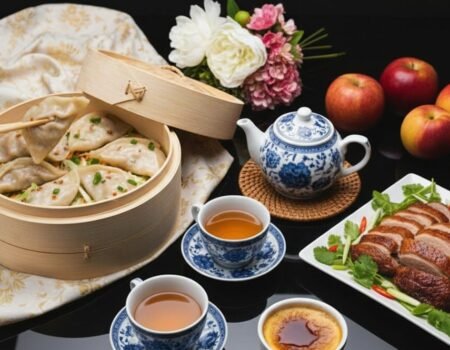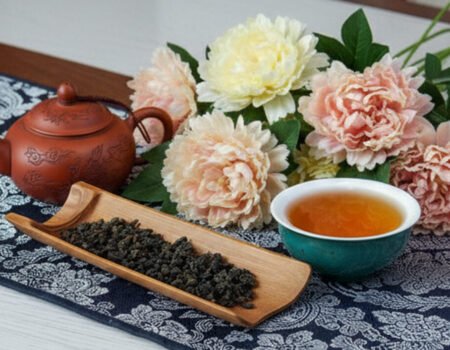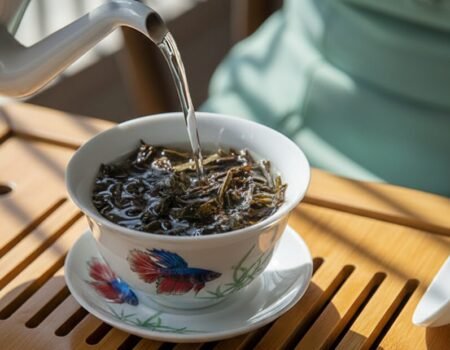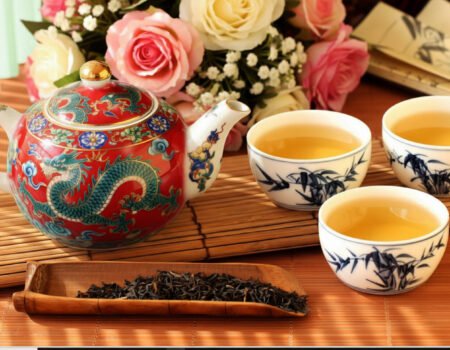Index
Index
Oolong tea sits between green and black tea on the oxidation scale, ranging from 8% to 85% oxidized. This middle ground creates a rich world of flavors that change based on where the tea grows and how it’s made.
This guide will walk you through the major oolong tea types from China and Taiwan, explain what makes each one special, and help you find your perfect cup. Get ready to explore the amazing range of oolong teas.
Key Takeaways
- Oolong tea falls between green and black tea with oxidation levels ranging from 8% to 85%, creating diverse flavor profiles from floral to woody.
- Fujian Province produces famous oolongs like Tie Guan Yin (Iron Goddess) with its orchid fragrance and Da Hong Pao (Big Red Robe), known for its complex mineral notes.
- Taiwan’s high mountain (Gaoshan) oolongs grow at 1,000-1,200 meters elevation, developing buttery textures and bright floral notes due to cool mountain air.
- Oriental Beauty tea gets its unique honey flavor when tiny leafhoppers bite the leaves, causing the plant to produce special compounds.
- Processing methods greatly impact flavor—light oxidation (8-25%) creates bright floral notes, while heavy oxidation (60-85%) produces deep, roasted flavors with caramel hints.
Oolong Tea Basics
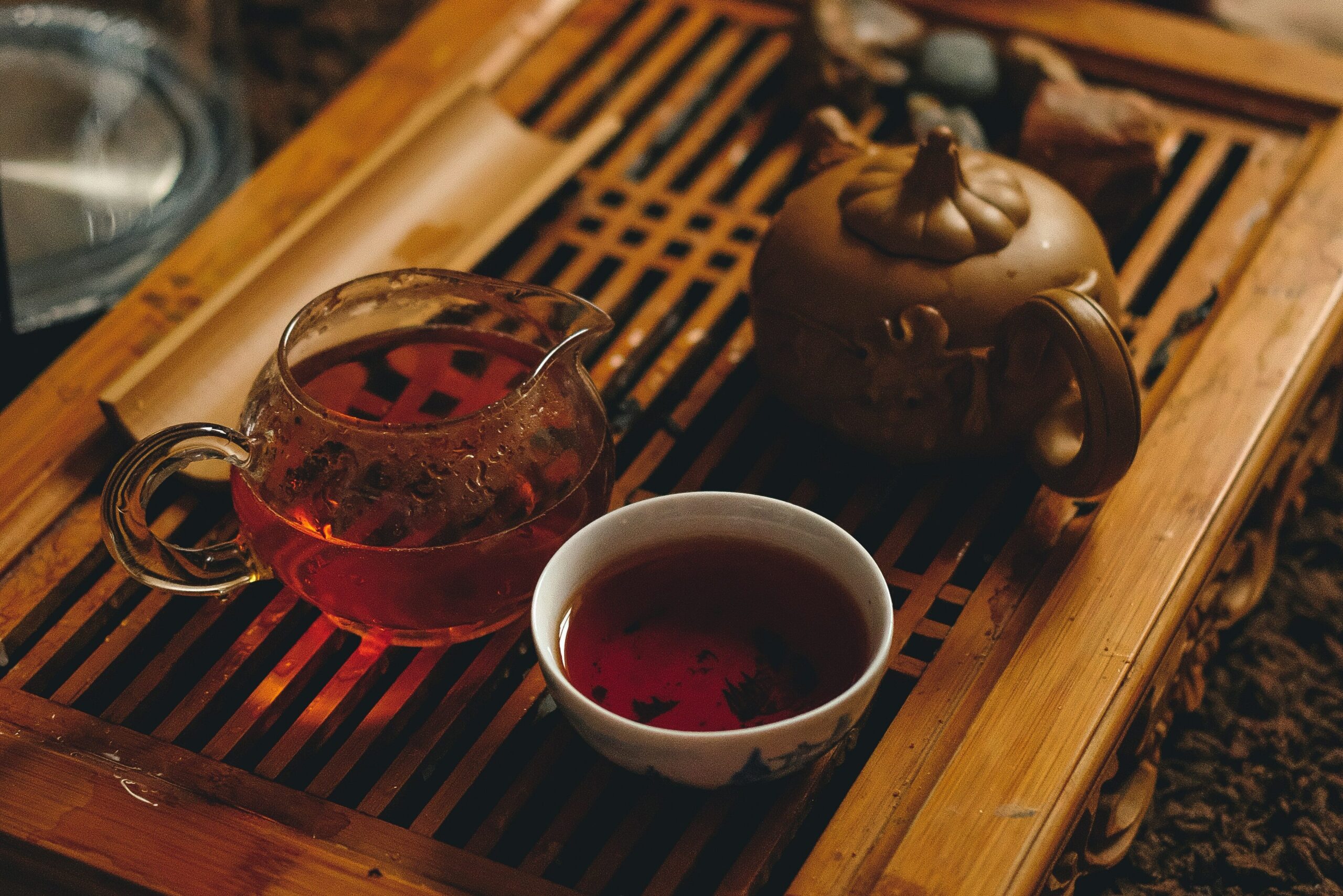
Oolong tea sits between green and black tea on the oxidation scale, creating a wide range of flavors from floral to toasty. The way tea leaves are processed – from withering to rolling to roasting – shapes the final taste in your cup.
What Makes Tea “Oolong”
Oolong tea stands in the middle ground between green and black teas on the oxidation scale. This special tea ranges from 8% to 85% oxidation, giving it unique flavors that can be floral, fruity, or woody.
The name “oolong” translates to “black dragon” in Chinese, hinting at its rich heritage and distinctive character. Tea farmers create oolong by withering the leaves under strong sun and then carefully controlling the oxidation process.
The magic of oolong happens during processing. After plucking leaves from the Camellia sinensis plant, tea masters bruise the edges of the leaves to start oxidation. They stop this process at just the right moment by heating the leaves, which creates oolong’s complex taste profile.
This partial oxidation sets oolong apart from green tea (minimal oxidation) and black tea (full oxidation). Different regions like Fujian Province in China and high mountains in Taiwan have developed their own styles, each with signature flavors and aromas.
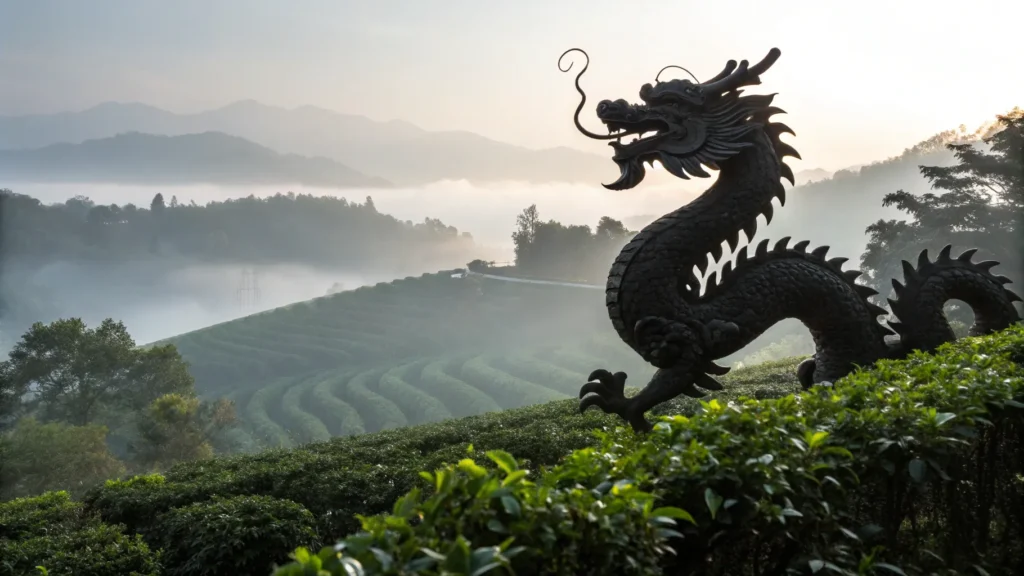
The Oxidation Spectrum (8-85%)
Now that you understand what makes a tea truly “oolong,” let’s explore the fascinating range of oxidation that gives these teas their distinct character. Oolong teas exist on a spectrum from 8% to 85% oxidation, creating an incredible variety of flavors.
This partial oxidation sits between green tea (minimally oxidized) and black tea (fully oxidized), offering tea lovers the best of both worlds.
Lightly oxidized oolongs (8-30%) display bright, floral notes with a fresh character similar to green tea. The leaves often maintain a greenish appearance with slightly browned edges.
Medium oxidized varieties (30-60%) develop fruity, honey-like qualities with a golden-amber brew. Highly oxidized oolongs (60-85%) showcase deep, complex flavors—woody, roasted, and sometimes smoky—resembling black tea but with unique characteristics all their own.
This oxidation range explains why oolong teas offer such diverse tasting experiences. The tea master controls this process carefully, watching leaf color change from green to red-brown as enzymes interact with oxygen.
Different regions have developed signature styles within this spectrum—Taiwanese producers often favor lighter oxidation while many Fujian varieties embrace medium to heavy oxidation levels.
Each percentage point along this scale brings new flavor possibilities to your cup.

Key Processing Methods
Oolong tea gets its unique character through six essential steps. First, tea leaves wither for 12-24 hours, softening them for the next stages. Next comes bruising, where leaves are gently shaken or tossed to start oxidation at their edges.
This controlled damage breaks cell walls and releases enzymes that transform the leaf chemistry. Oxidation follows as the bruised leaves rest in a carefully managed environment. Tea masters stop this process at exactly the right moment—anywhere from 8% to 85%—through fixation, usually with heat.
The leaves then undergo rolling to shape them and enhance flavor release before final drying locks in their character.
The skill of the tea producer shows most clearly in how they manage oxidation levels. Light oxidation (8-25%) creates bright, floral teas with green notes. Medium oxidation (25-60%) develops honey and fruit tones, while heavy oxidation (60-85%) produces deep, roasted flavors with caramel hints.
These processing choices create the vast spectrum of oolong styles you’ll discover as we explore regional varieties from Fujian and beyond.
Understanding Roasting Levels
Roasting transforms oolong tea by reducing moisture and concentrating flavors. Light or “jade” oolongs undergo minimal heat treatment, which preserves their floral notes and creates a smooth, buttery texture in your cup.
At the opposite end, heavily roasted varieties develop rich, deep flavors that might remind you of coffee with their thickness and intensity. The roasting process directly affects what you’ll taste – traditional styles like Tieguanyin rely on specific roasting techniques to achieve their bold, complex profiles that tea lovers seek out.
Many tea masters adjust roasting levels based on the tea leaves’ natural characteristics to highlight their best qualities.
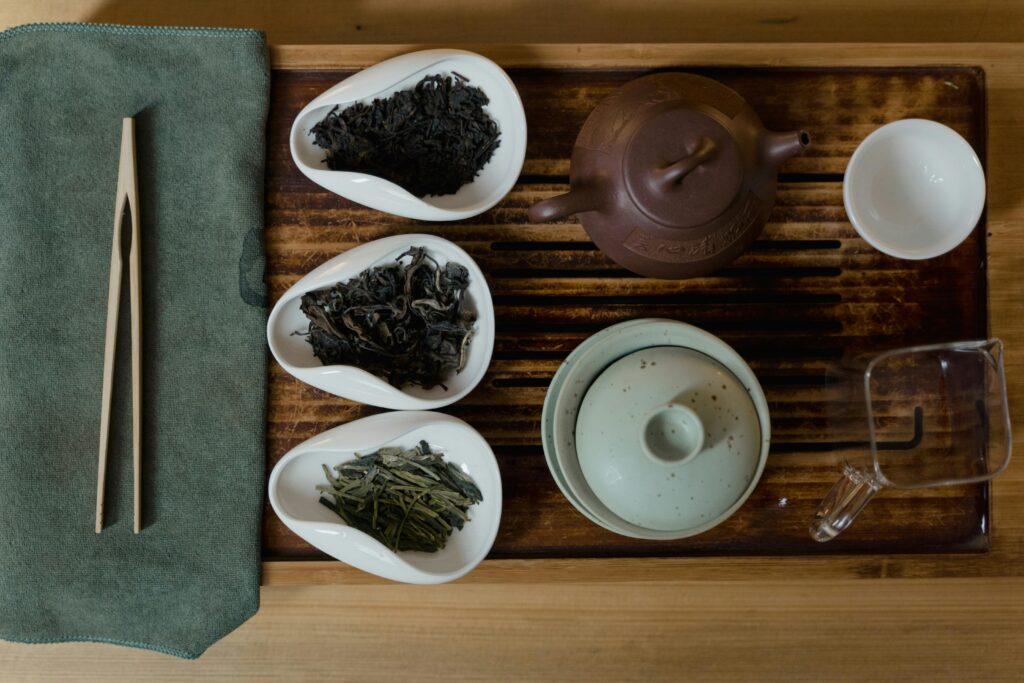
Classic Oolong Styles
Classic oolong styles range from light floral varieties to rich, dark roasted types that showcase the amazing range of flavors possible through different oxidation levels and processing methods – join us as we explore these distinct tea profiles and learn how each style develops its signature taste.
Light Oxidation Varieties
Light oolong teas undergo minimal oxidation, typically between 8-25% of the process. This limited oxidation creates bright, sweet flavors with distinct floral notes that dance across your palate. Baozhong (Pouchong) represents one popular light oolong, prized for its fresh, floral aroma and delicate finish.
Milk Oolong stands out as another remarkable light oxidation tea, famous for its creamy texture and natural milk-like taste. The semi-oxidation process preserves more of the tea plant’s natural compounds while developing unique characteristics impossible to find in green or black teas.
Light oolongs retain their fresh qualities while gaining depth through careful processing techniques perfected over centuries in regions like Taiwan and Fujian.
These delicate teas require precise brewing to fully appreciate their nuanced flavors. Water temperature between 185-195°F (85–90°C) works best for most light oolongs, allowing the leaves to unfurl gradually without scorching.
Tie Guan Yin, also known as Iron Goddess of Mercy, exemplifies the category with its bright cup color and sweet aftertaste that lingers pleasantly after each sip.
Medium Oxidation Classics
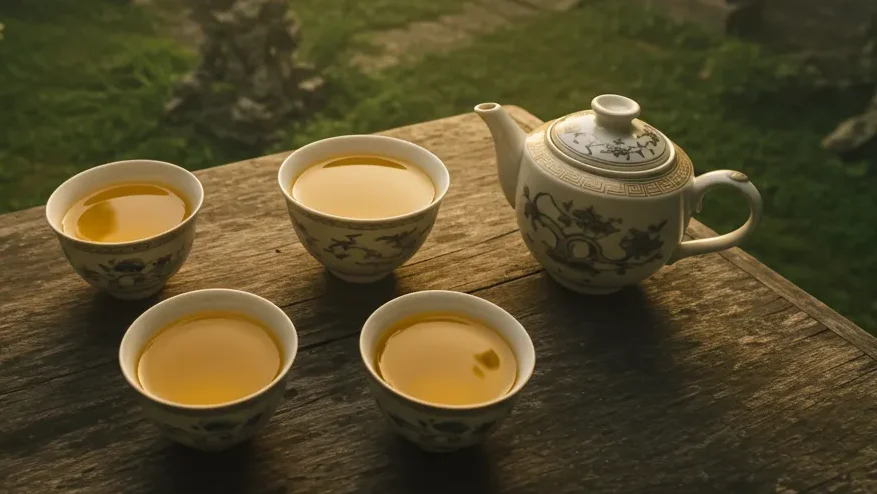
Medium oxidation oolongs sit perfectly between green and black teas on the processing spectrum. These balanced teas offer the best of both worlds – floral sweetness from lighter styles plus deeper nutty notes from darker varieties.
Tie Guan Yin (Iron Goddess of Mercy) stands as the flagship of this category, with its distinctive orchid aroma and smooth mouthfeel. Traditional Dong Ding from Taiwan delivers a rich, toasty character with honey undertones that tea enthusiasts prize for its complexity.
The oxidation level between 40-60% creates these classic profiles that showcase the tea plant’s full range of flavors. You’ll notice warm, mellow notes paired with subtle fruitiness that makes these teas approachable yet sophisticated.
Many tea masters consider medium oxidation the sweet spot for appreciating oolong’s true character without extremes dominating the cup. The roasting techniques applied to these teas enhance their natural qualities while adding depth that reveals itself across multiple steepings.
Next, we’ll explore the distinctive types of oolong from China’s Fujian province, the historical birthplace of these remarkable teas.
Heavy Oxidation Types

Heavy oxidation oolong teas undergo 40-85% oxidation, creating rich flavors and deeper colors. These teas display robust profiles with notes of dark fruits, roasted nuts, and sometimes hints of chocolate.
Da Hong Pao stands out as the king of heavily oxidized oolongs, prized for its strong character and complex taste profile. The tea leaves turn a deep amber-brown during processing, resulting in a darker brew that many tea lovers compare to fine wines.
Different regions craft these darker oolongs using specific methods. The Wuyi Mountains produce rock teas with mineral undertones, while some Taiwanese producers create aged heavy oolongs with unique depth.
The production varies widely across tea-growing areas, much like wine styles differ between vineyards. These teas typically contain moderate caffeine levels and release their full flavor potential through multiple infusions in proper brewing vessels.
Modern Processing Innovations
Taiwan’s tea industry has transformed oolong production over the past two centuries. Traditional methods now work alongside cutting-edge techniques that create distinct flavor profiles.

Farmers have developed precise oxidation controls that allow for consistent quality across batches, something impossible with older methods.
New roasting technologies have changed how oolong tastes and smells. Electric roasters now offer temperature precision that charcoal roasting cannot match, giving tea masters more control over the final product.
This shift has led to lighter, more floral oolong varieties like Jin Xuan (Milk Oolong) that showcase delicate notes rather than deep roasted flavors.
Computer monitoring systems track humidity, temperature, and oxidation levels throughout processing. These tools help create specialty teas like the famous Dongfang Meiren (Oriental Beauty), which relies on precise leaf handling.
Modern vacuum-sealing techniques also extend shelf life while preserving the complex flavors that make quality oolong tea sought after by collectors and casual drinkers alike.
Understanding Processing Impact on Flavor
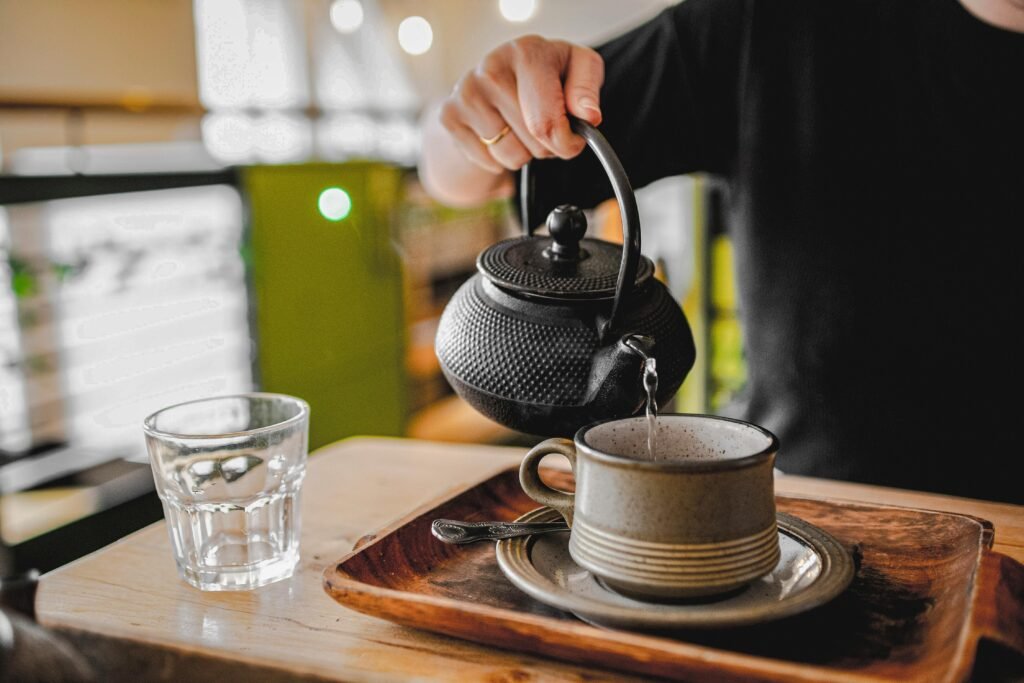
Processing methods create the vast flavor range found in oolong teas. Oxidation levels directly shape what you’ll taste in your cup – teas with 8-20% oxidation offer bright, floral notes that dance on your palate.
These lighter oolongs often showcase the natural sweetness of the leaf. In contrast, oolongs processed to 60-80% oxidation develop deeper, more mature flavor profiles with honey, fruit, and woody tones that linger longer.
Roasting adds another dimension to oolong’s flavor profile. Light roasting preserves the tea’s original character while adding subtle warmth. Medium roasting brings out caramel notes and reduces grassiness.
Heavy charcoal roasting transforms the tea completely, creating rich, toasty flavors that can mask the leaf’s natural qualities. The tea master must balance oxidation and roasting carefully – too much of either process can ruin even the finest leaves from ancient tea trees.
Growing conditions play a crucial role in flavor development before processing begins. High-altitude gardens produce leaves with more complex flavors due to cooler temperatures and daily temperature shifts.
Older tea trees, with their deeper root systems, draw more minerals from the soil that translate to richer tastes and better durability through multiple steepings. Seasonal harvests also affect flavor intensity, with spring pickings often showing more delicate profiles than autumn harvests.
Types of Oolong from Fujian
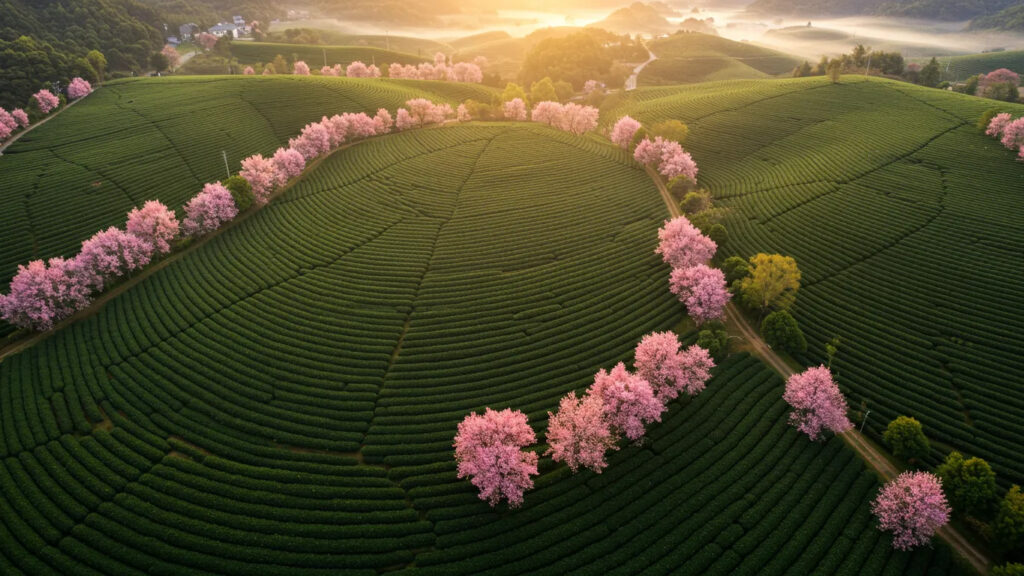
Fujian province stands as the birthplace of some of the world’s most prized oolong teas, with each type showing unique traits based on local growing conditions and processing methods – from the floral notes of Tie Guan Yin to the deep, rocky character of Da Hong Pao that tea fans can’t stop talking about.
Anxi Tie Guan Yin: The Iron Goddess
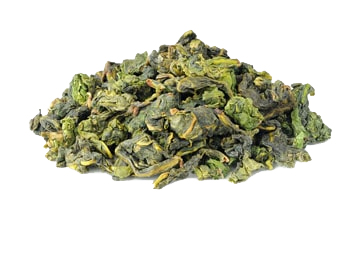
Tie Guan Yin, known as the Iron Goddess, stands as one of China’s most treasured oolong teas from Anxi County. This famous tea captivates drinkers with its bright orchid fragrance and sweet, nectary taste profile that lingers pleasantly.
The leaves create a smooth cup with mellow, creamy flavors featuring subtle hints of vanilla and pine nuts that tea enthusiasts prize worldwide.
You can find this partially oxidized tea at various price points depending on quantity and quality, with larger packages typically offering better value per gram.
Many tea shops classify Tie Guan Yin as a premium Chinese tea due to its complex processing methods that bring out its distinctive character. The tea brewing technique greatly affects how these special flavor notes develop in your cup.
Wuyi Rock Teas (Yan Cha)
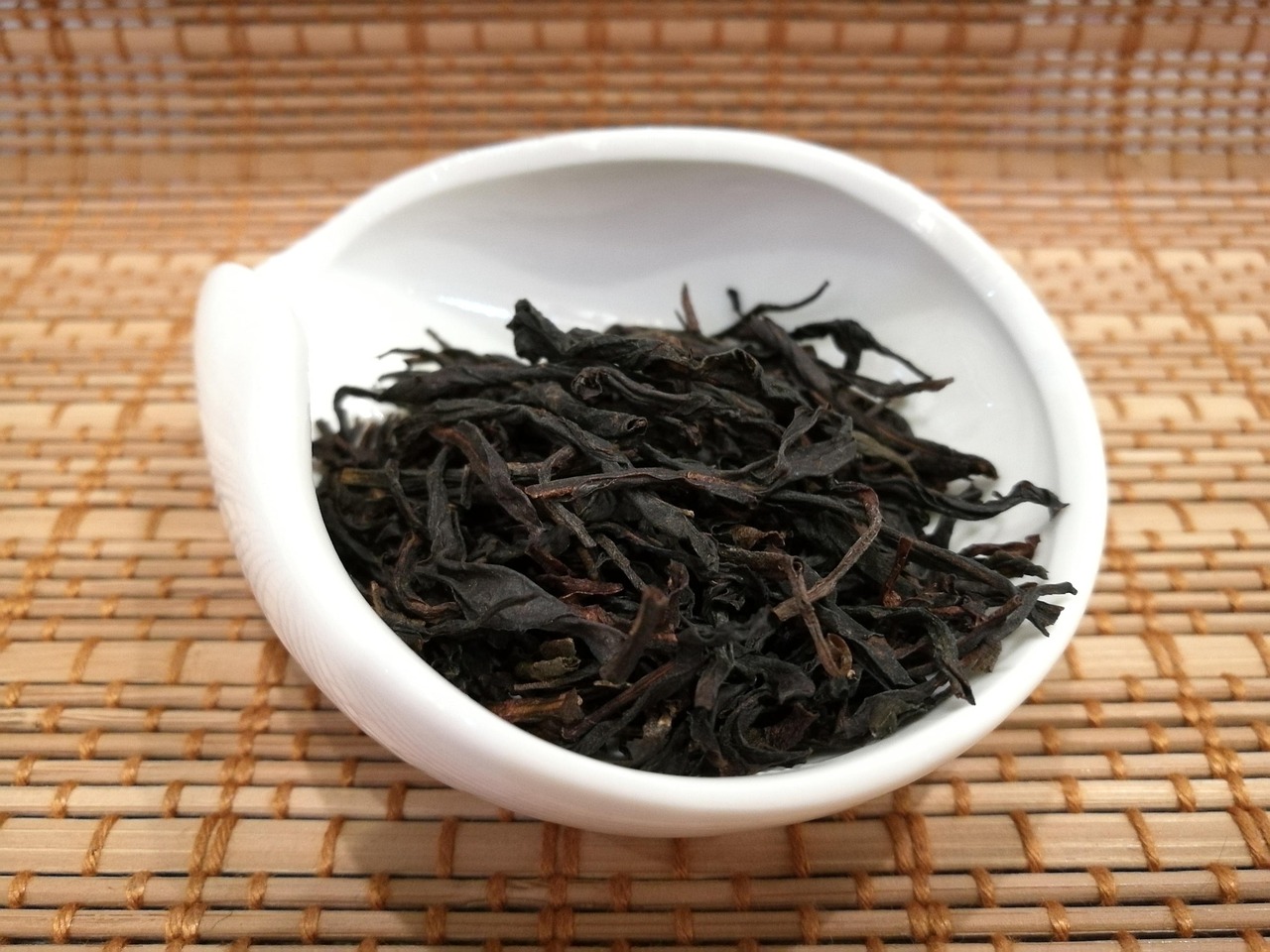
Wuyi Rock Teas grow in the mineral-rich soil of Fujian’s Wuyi Mountains, creating teas with a distinct “rock taste” or “yan yun.” These famous oolongs include several prized varieties like Da Hong Pao (Big Red Robe), Shui Xian (Water Fairy), Qi Lan (Rare Orchid), and Fo Shou (Buddha’s Hand).
Da Hong Pao stands as the most celebrated, offering complex floral and fruity notes balanced with a strong mineral character. The steep cliffs and unique climate of this region give these teas their special qualities.
The processing of Yan Cha involves careful oxidation and roasting steps that bring out their deep flavors. Traditional charcoal roasting adds smoky, caramel notes to these teas, while the oxidation level (typically 40-70%) creates their amber color.
Qi Lan delivers fragrant fruity notes with hints of roasted almond and vanilla that tea lovers seek. Each sip reveals layers of flavor that change across multiple steepings, making these teas perfect for gongfu brewing methods.
Next, we’ll explore another famous oolong from Fujian province – the renowned Tie Guan Yin, also known as Iron Goddess of Mercy.
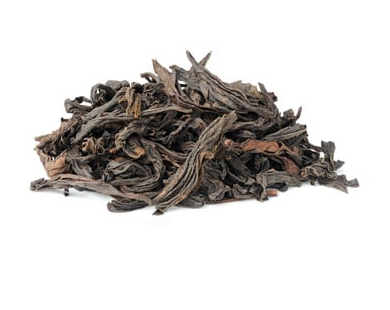
Da Hong Pao: The King of Rock Teas
Da Hong Pao stands as the most famous rock tea from China’s Wuyi Mountains. Tea experts prize this legendary oolong for its deep, complex flavor profile that combines rich mineral notes with a smooth, roasted character.
The leaves undergo extensive oxidation, which creates its signature bold taste and amber-red brew. Many tea shops sell lower-grade versions, but authentic Da Hong Pao comes from specific rock cliffs in the Fujian province.
This premium oolong offers a distinct drinking experience unlike other teas. The flavor starts with a warming roasted note that shifts to a sweet, fruity finish with each sip. Chinese tea culture holds Da Hong Pao in high regard, often serving it during special occasions or to honored guests.
Its name translates to “Big Red Robe,” linking to an ancient story where this tea helped cure a Ming Dynasty emperor’s mother, earning it royal status. True Da Hong Pao brews multiple times, with each steeping revealing different layers of its robust character.
Classic Wuyi Varieties

Beyond the famous Da Hong Pao, Wuyi Mountain offers several classic oolong varieties worth exploring. These teas share similar processing methods but display unique flavor profiles based on their specific cultivars and growing locations.
Rougui (meaning “cinnamon”) stands out with its warm spice notes and floral hints, creating a balanced and complex taste experience. Tea masters often use traditional charcoal roasting techniques to develop rich flavors in these dark oolongs.
Wuyi rock teas (Yan Cha) include other notable varieties like Shui Xian (Water Fairy) and Tie Luo Han (Iron Warrior Monk). Each tea reflects the mineral-rich soil of the rocky terrain where they grow.
Beidou, a direct descendant cultivar from the original Da Hong Pao mother trees developed in the 1990s, offers distinctive toffee and dried fruit notes that tea enthusiasts prize. These teas typically undergo heavier oxidation than their Taiwanese counterparts, resulting in deeper, more robust flavor profiles.
Note: Some specialty tea companies market these traditional varieties under names like “Heritage Rougui” or “Heritage Beidou” to indicate traditional processing methods using charcoal roasting.
Modern Fujian Innovations
While Classic Wuyi varieties honor tradition, Fujian tea makers have embraced new techniques to meet changing tastes. Modern Fujian innovations include updated oxidation methods that create lighter, more floral oolong profiles.
Tea farmers now use controlled temperature rooms and precise humidity settings to craft consistent batches year-round.
Fujian producers have also developed new tea cultivars that resist common plant diseases while maintaining rich flavor profiles. These innovations have expanded the oolong tea market globally, with specialty varieties gaining popularity among tea enthusiasts.
Many modern Fujian oolongs feature unique processing steps that bring out sweet, fruity notes not found in traditional versions. The region continues to balance time-tested methods with fresh approaches, ensuring both quality and variety in their tea production.
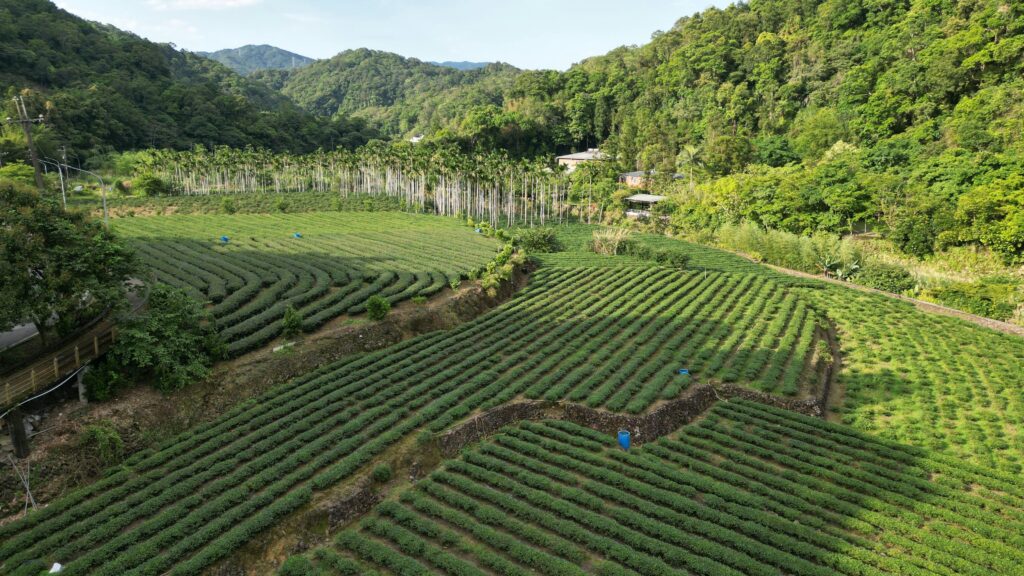
Types of Oolong from Taiwan
Taiwan creates some of the world’s most prized oolong teas, from the misty high mountain Gaoshan varieties to the honey-sweet Oriental Beauty – discover these island treasures and how their unique growing conditions shape their distinct flavors.
High Mountain (Gaoshan) Oolongs
Gaoshan oolongs rank among Taiwan’s most prized tea treasures, grown at impressive elevations between 1,000 to 1,200 meters above sea level. These special teas thrive in the cool mountain air and misty conditions that slow leaf growth and concentrate flavors.
The result creates a distinctive taste profile featuring buttery textures, bright floral notes, and fruity undertones that tea enthusiasts eagerly seek out.
Each mountain region produces Gaoshan with unique characteristics based on specific growing conditions. Ali Mountain (Alishan) teas often display sweet, fragrant qualities, while Li Shan varieties tend toward creamier, more complex flavor profiles.
Brewing these premium oolongs requires careful attention to water temperature and steeping time to unlock their full potential. Most tea masters recommend multiple short infusions rather than a single long steep to experience the evolving flavor layers of these exceptional teas.
Dong Ding: The Traditional Classic
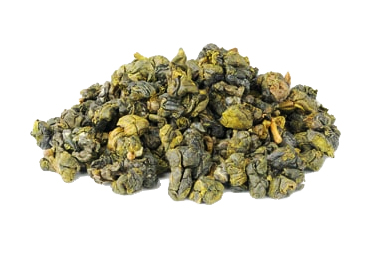
Dong Ding oolong stands as Taiwan’s most celebrated traditional tea, grown on the slopes of Dongding Mountain in Lugu. This classic variety uses the prized Qingxin Oolong cultivar, which tea masters process through six distinct steps with only 15% fermentation.
The light oxidation preserves its natural sweetness while developing a rich, complex flavor profile that sets it apart from other oolongs.
Tea enthusiasts prize Dong Ding for its strong aroma and natural sweetness that lingers on the palate. Each sip offers a smooth texture with notes that can range from floral to fruity, depending on roasting levels.
Many consider this Taiwanese tea the perfect introduction to high-quality oolong because it balances complexity with approachability. Proper brewing brings out its full character – use water around 195°F and steep for about 2-3 minutes to experience what makes this mountain tea a true classic.
Oriental Beauty (Bai Hao)

Oriental Beauty is typically priced as a premium tea due to its unique production process. This premium tea develops its unique honey and ripe fruit fragrances through a fascinating natural process.
Tiny leafhoppers bite the tea leaves, causing the plant to produce defensive compounds that transform into sweet, complex flavors during oxidation. The tea leaves show a beautiful mix of colors from green to brown with silvery tips, earning its poetic name.
Tea masters carefully harvest and process these bitten leaves using traditional methods that maximize the natural sweetness. Each cup delivers a smooth texture with no astringency and notes that might remind you of muscat grapes or peaches.
Next, we’ll explore Milk Oolong and other modern Taiwanese cultivars that offer different flavor experiences.
Milk Oolong and Modern Cultivars
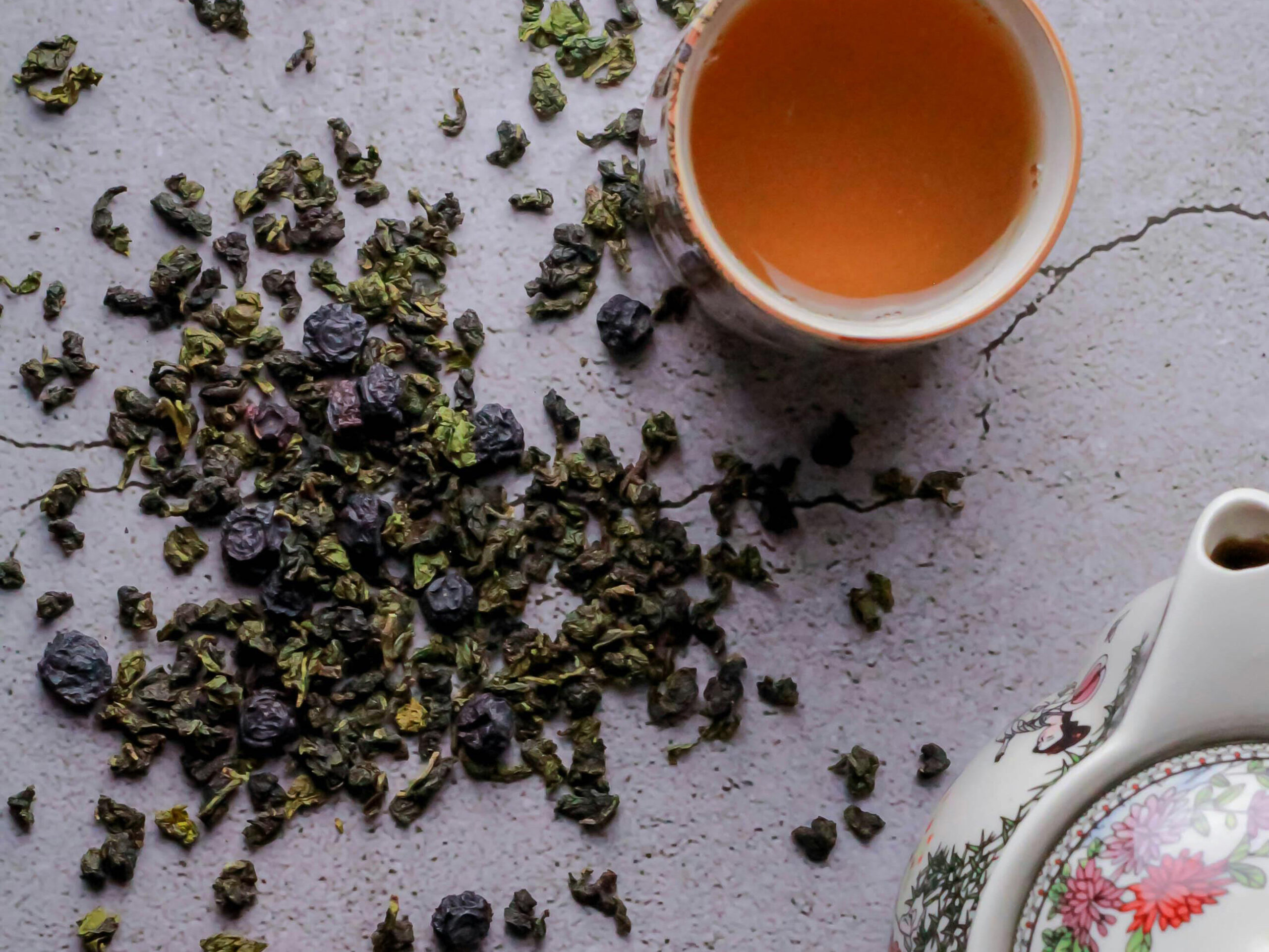
While Bai Hao offers complex honey notes, Taiwan’s tea innovation continues with its remarkable Milk Oolong. This special tea delivers natural milk flavors without any additives, making it stand out in the oolong world.
Taiwan’s Jin Xuan cultivar (also called Golden Lily) produces this creamy profile through specific growing conditions and processing techniques. The tea leaves contain compounds that create a buttery, smooth taste that many tea drinkers find irresistible.
Modern Taiwanese cultivars extend beyond Milk Oolong to showcase unique flavor profiles. These teas result from decades of careful plant breeding aimed at developing distinctive taste characteristics.
Four Seasons Spring, for example, offers floral notes year-round, while Cui Yu (Jade Oolong) delivers a bright, fresh profile with subtle fruit hints. Each cultivar responds differently to processing methods, giving tea masters many options to craft signature styles.
Loose leaf versions of these teas provide the best drinking experience. The whole leaves fully unfurl during brewing, releasing optimal flavor compounds into your cup. Taiwan’s high mountain growing regions add mineral notes and sweetness to these teas.
The combination of innovative cultivars and traditional processing methods has established Taiwan as a global leader in premium oolong production, especially for those seeking naturally sweet, aromatic teas with complex flavor profiles.
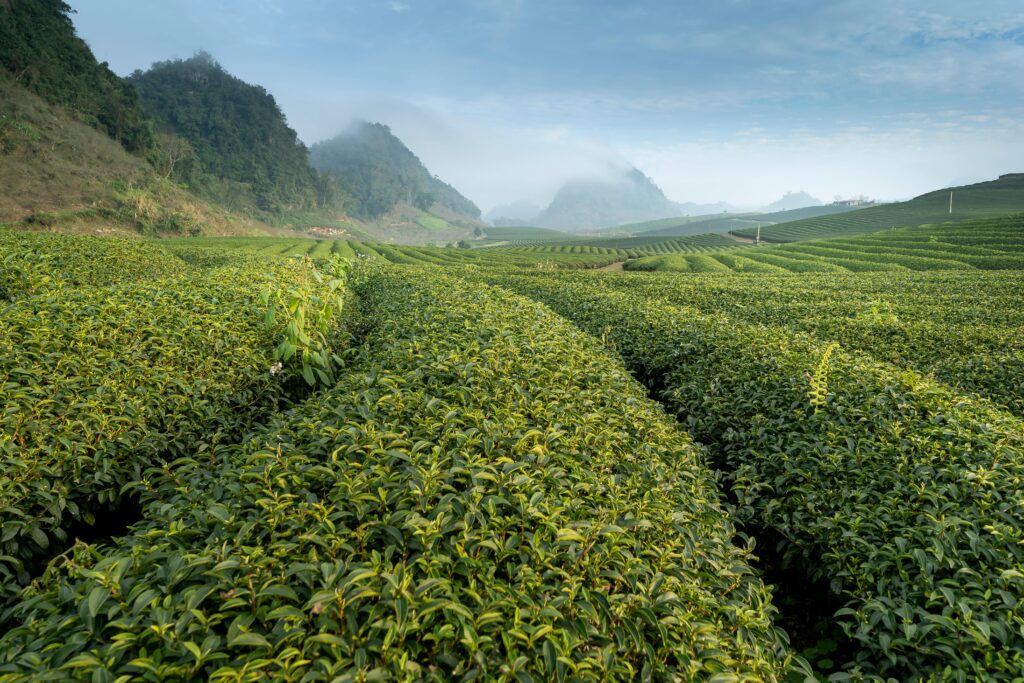
Regional Specialties
Beyond milk oolong and modern cultivars, Taiwan boasts distinct regional specialties that showcase the island’s diverse terroir. Each area produces unique oolong profiles based on local growing conditions.
Taiwan’s tea regions contribute to about 20% of global oolong production, with each zone developing signature characteristics.
High mountain areas like Alishan create teas with large, tightly rolled leaves and sweet, floral aromas that tea lovers prize. The elevation affects how the tea plants grow, resulting in slower leaf development and more complex flavors.
Alishan oolong stands out with its honeyed sweetness and subtle fruit notes that persist through multiple steepings.
Dong Ding region specialties undergo 15-30% oxidation, creating a perfect balance between green tea freshness and darker oolong depth. These teas deliver sweet, creamy flavors with notes of warm spice and toasted nuts.
The specific soil composition and climate of each growing area imparts unique mineral qualities to the finished tea, making regional specialties worth exploring for both new and experienced tea drinkers.
Roasting and Processing Styles
Roasting transforms oolong tea from mild to rich, with traditional charcoal methods adding smoky depth while modern electric techniques create more consistent flavors – read on to discover how these methods shape your cup.
Traditional Charcoal Roasting
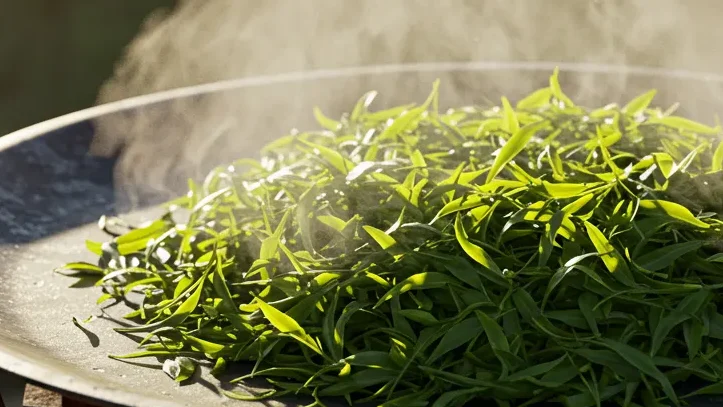
Traditional charcoal roasting stands as the backbone of classic oolong tea production. Tea masters use this time-honored method to enhance the natural flavors in teas like Tie Guan Yin and Da Hong Pao.
The process removes moisture and concentrates the tea’s aroma, creating deeper, more complex taste profiles. Many tea drinkers prize these roasted varieties for their rich, coffee-like thickness and intense flavors.
Charcoal-roasted oolongs develop unique taste notes that electric roasting cannot match. The slow, steady heat from bamboo or fruit tree charcoal allows the leaves to transform gradually without burning.
This careful technique brings out sweet, toasty qualities while preserving the tea’s original character. Chinese oolong producers often roast their teas multiple times, with rest periods between each session, to build layers of flavor depth that tea enthusiasts worldwide seek out.
Modern Electric Roasting
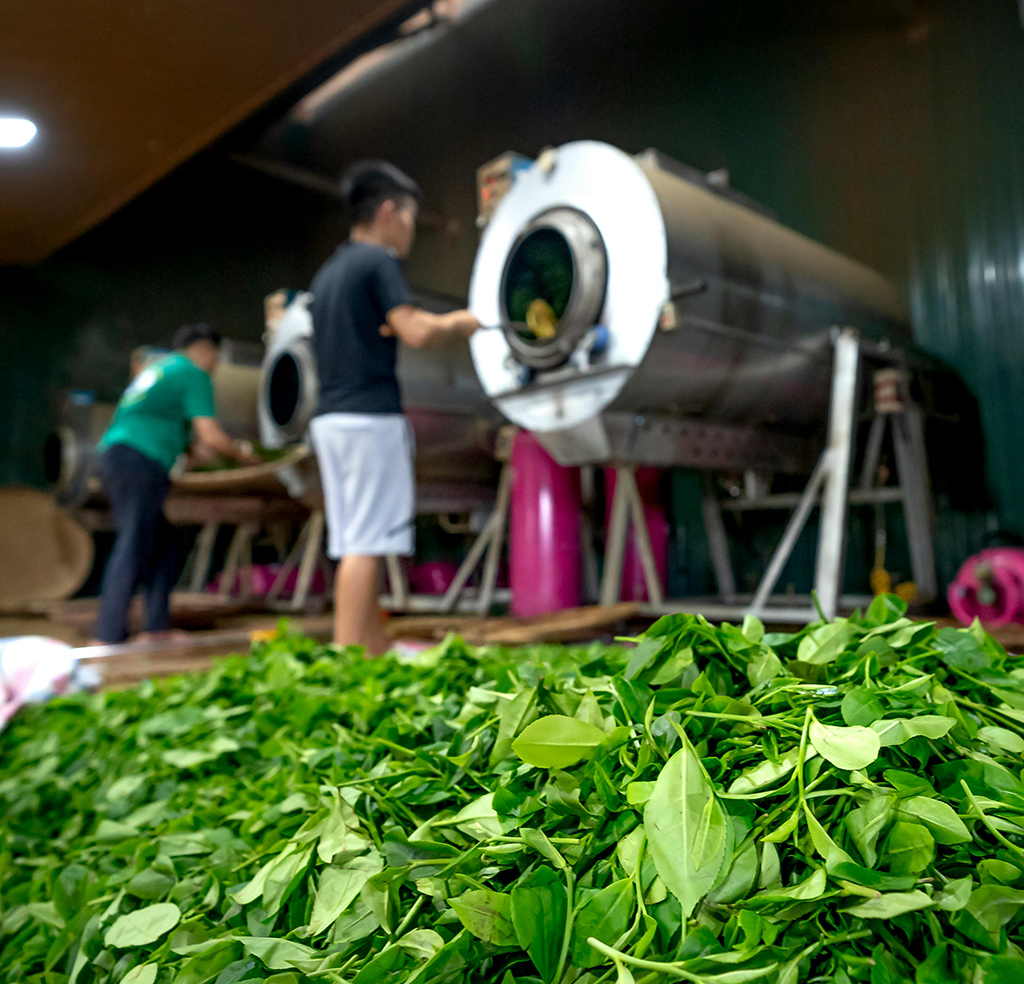
Electric roasting has changed how tea producers finish their oolong teas. Unlike charcoal methods, electric roasters offer precise temperature control and consistent results. Tea masters can now program exact heat curves that bring out specific flavors in different oolong varieties.
This technology helps create reliable batches of popular styles like Dong Ding or Jin Xuan without the smoke notes that charcoal sometimes adds.
Many modern facilities use computer-monitored systems to track each stage of the roasting process. The machines can adjust heat levels automatically based on the tea’s moisture content and oxidation level.
This precision allows for subtle flavor development that highlights the natural qualities of high mountain oolongs while reducing the risk of burning. Electric roasting also requires less skill to operate, making quality oolong production more accessible to newer tea companies.
The best electric roasters still need skilled operators who understand how heat affects the tea leaves. These machines work well for light to medium roasts but sometimes struggle to create the deep, complex flavors found in traditionally processed teas.
Multiple roasting techniques combine both methods to achieve balanced flavor profiles that appeal to today’s tea drinkers. Next, we’ll explore how different regional varieties develop their unique characteristics through specialized processing.
Multiple Roasting Techniques

Premium oolong teas often undergo several roasting sessions to develop their complex flavor profiles. Master tea producers apply different heat levels at specific intervals, allowing the leaves to rest between sessions.
This multi-stage approach creates deeper flavors while preserving the tea’s natural character. Each roasting cycle adds new dimensions to the tea, building layers of taste that range from subtle fruit notes to rich caramel undertones.
The roasting degree dramatically shapes an oolong’s final taste profile. Lightly roasted varieties maintain their bright floral qualities while gaining a gentle toasted edge. Medium roasts develop nutty characteristics with hints of caramelized sweetness.
Dark-roasted oolongs offer deep, smoky flavors with complex woody notes that linger on the palate. Traditional styles like Tieguanyin have evolved through various roasting techniques, with both modern and classic versions available to tea enthusiasts.
Green-Style Processing
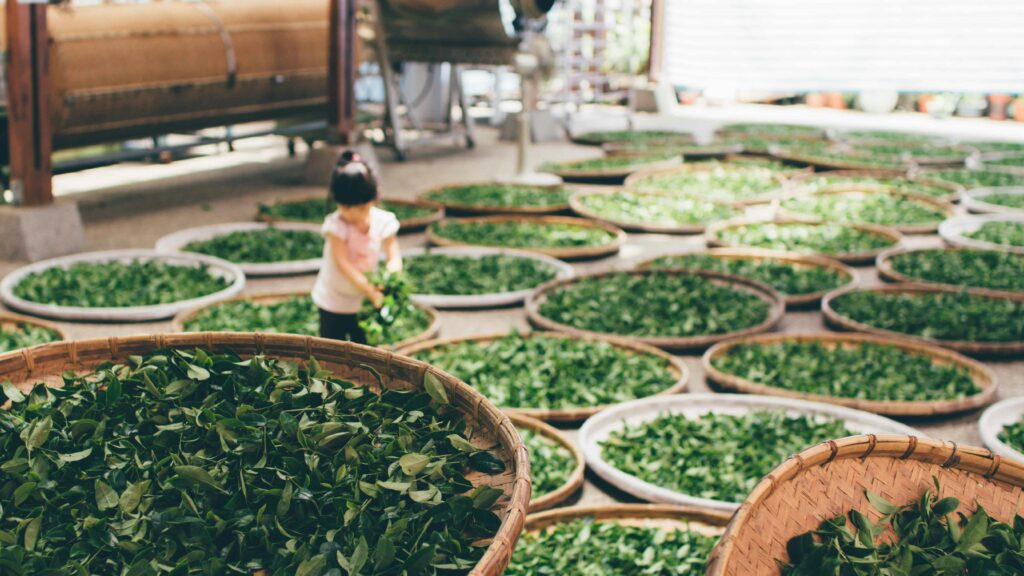
Green-style processing creates oolong teas that retain their fresh, vegetal qualities through minimal oxidation. This modern technique draws from traditional Chinese methods but focuses on preserving the tea’s natural catechins – compounds that contribute to both health benefits and flavor.
Taiwanese producers have perfected this approach, allowing only 8-12% oxidation before heat is applied to halt the process. The leaves maintain their bright green appearance while developing the complex flavor profile that sets oolong apart from standard green tea.
The result delivers a cup with light, floral notes and a mellow yet brisk taste characteristic of quality oolong. Unlike heavily oxidized varieties, these green-style oolongs offer more antioxidants due to the processing methods that Taiwan’s tea masters have refined over decades.
Many tea enthusiasts start their oolong journey with these lighter styles before exploring the full oxidation spectrum. Jin Xuan and high mountain Gaoshan teas showcase this processing style beautifully, with their sweet profiles and smooth finish.
Impact on Flavor Development- The Oxidation Spectrum (8-85%)
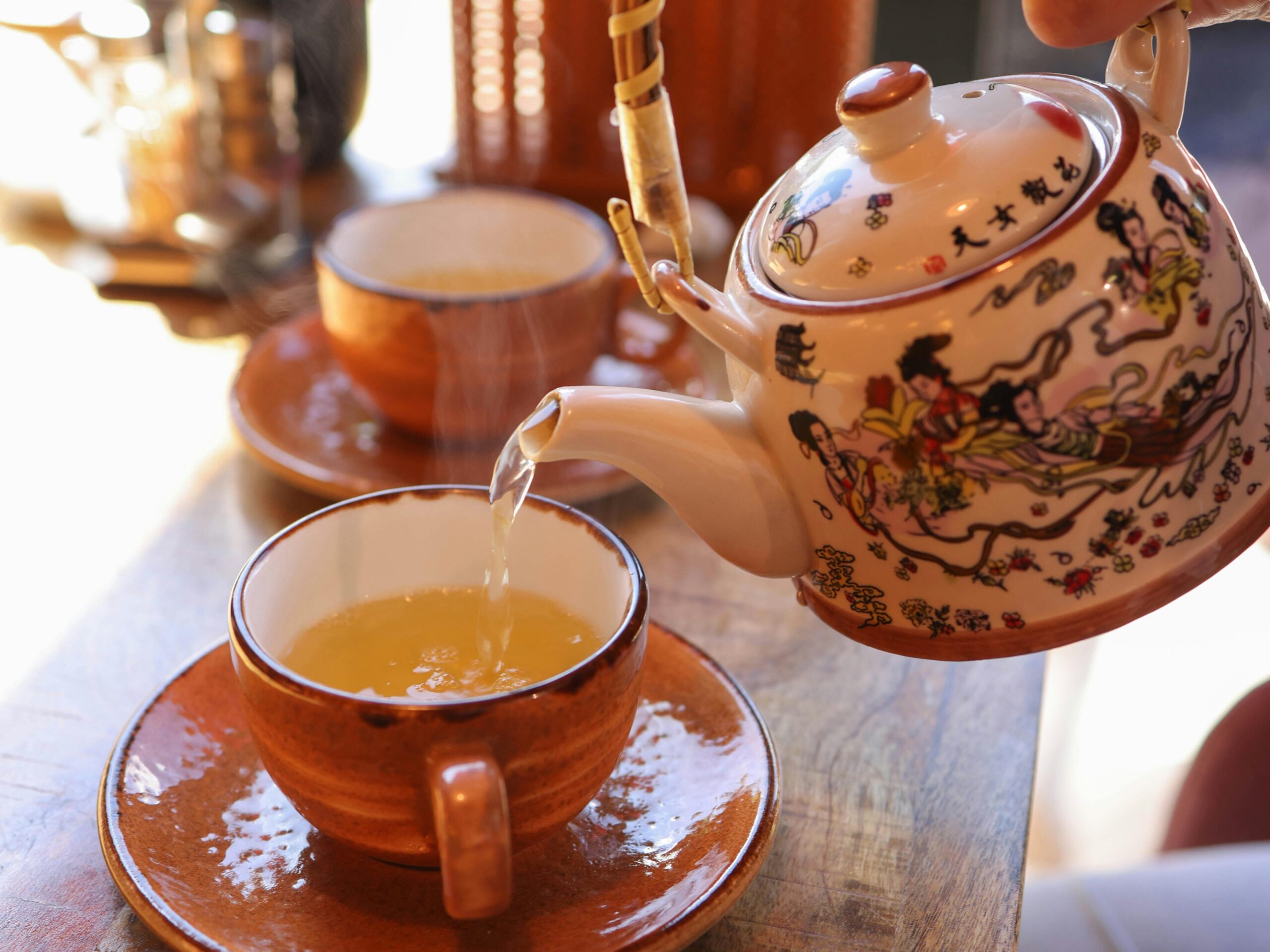
Oolong tea sits in a sweet spot between green and black teas, with oxidation levels ranging from 8% to 85%. This wide spectrum creates an amazing variety of flavors that can’t be found in other tea types.
Lightly oxidized oolongs (8-25%) offer bright floral notes and a fresh character, while medium oxidation (25-60%) develops fruity and honey-like qualities. Heavily oxidized varieties (60-85%) showcase rich woody, roasted, and sometimes smoky profiles that tea lovers seek out.
The oxidation process transforms tea compounds through chemical reactions that occur as the leaves interact with oxygen. Tea masters control this process carefully, knowing exactly when to halt oxidation through the “Kill Green” step.
This precision affects everything from the tea’s color to its aroma and taste. The withering stage also plays a crucial role in developing the complex flavors that make oolong so special.
Next, we’ll explore how roasting techniques further enhance these flavor profiles.
Notable Regional Varieties
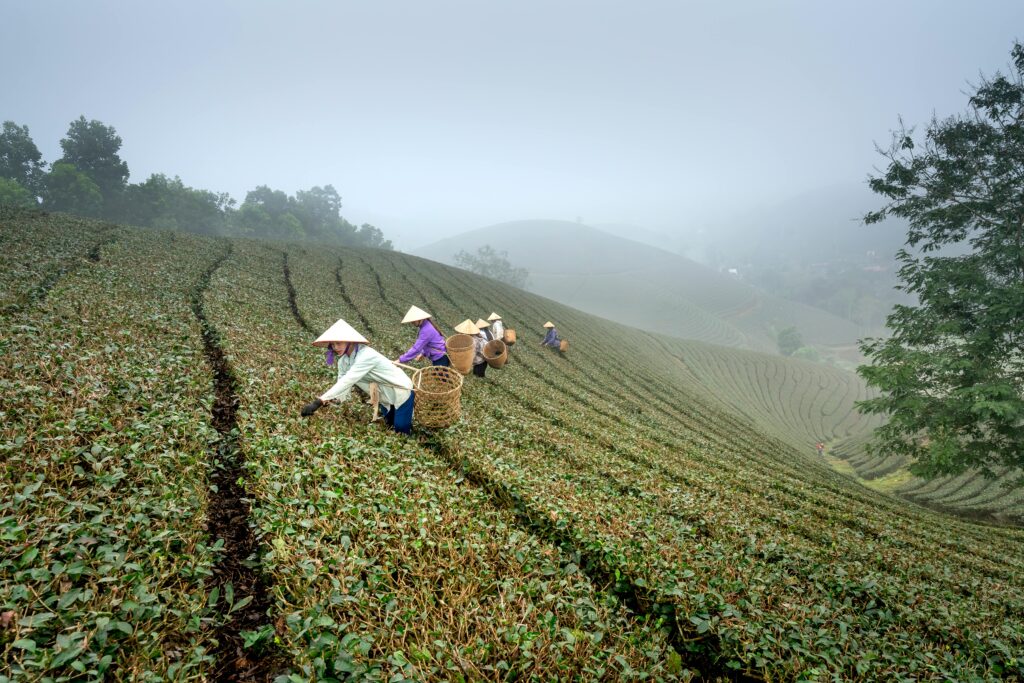
Beyond China and Taiwan, oolong tea has spread to other regions with unique local spins – from Vietnam’s floral notes to India’s bold experiments – each offering a fresh take on this classic tea style.
Guangdong Dan Cong
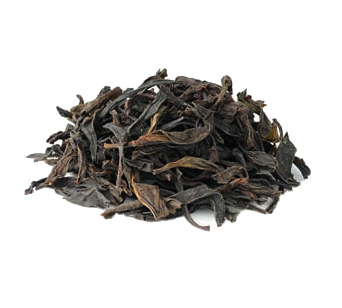
Guangdong Dan Cong stands as one of China’s most distinctive oolong teas, traditionally grown from single tea trees with deep root systems. These ancient trees absorb varied minerals and nutrients, creating teas with natural flavor profiles that mimic fruits and flowers.
Tea masters in Phoenix Mountain craft these rare teas that taste like honey orchid (Mi Lan Xiang), almond (Xing Ren Xiang), grapefruit (You Hua Xiang), or the famous “duck shit aroma” (Ya Shi Xiang) without any added flavors. The most prized varieties include:
Lao Cong Dan Cong – Teas from trees over 100 years old, offering exceptional depth and complexity. Notable examples include Lao Cong Wen Zhong (from the Wen family’s famous tree), Lao Cong Xiong Di Zai (the “brothers” tree), and Lao Cong Song Zhong (Song dynasty cultivar with peachy notes).
Phoenix Mountain oolong boasts a rich heritage spanning over 900 years, making it a treasure in Chinese tea culture. The name “Dan Cong” originally meant “single bush,” though today it refers to Phoenix oolongs with distinctive flavor profiles.
The Wu Dong village area at elevations of 1,000-1,200 meters produces the finest Dan Cong teas. Many tea enthusiasts prize these medium-to-heavily oxidized oolongs for their intense aromas and ability to produce multiple flavorful steepings from a single batch of leaves.
Vietnamese Oolongs
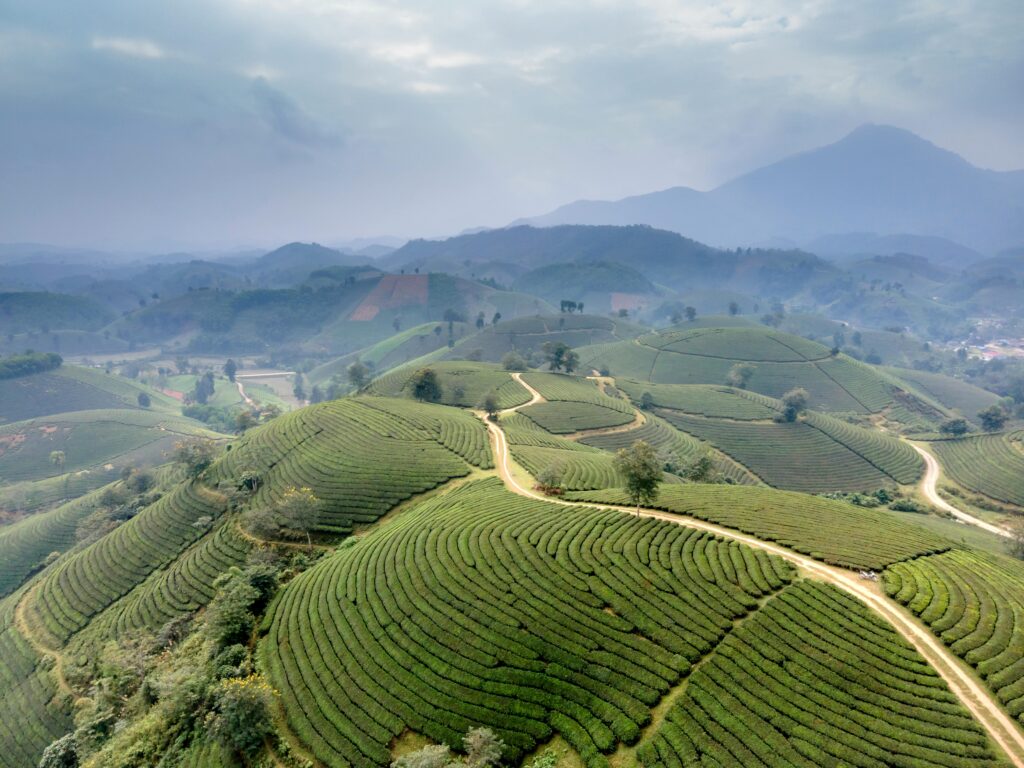
Vietnamese oolong tea grows in the northern highlands where cool climates and high elevations create ideal growing conditions. These teas often show strong Taiwanese influence, as many farmers brought Taiwan’s tea expertise and plant varieties to Vietnam in the 1990s.
Popular Vietnamese oolongs include Jin Xuan (milk oolong) and high mountain varieties that offer floral notes with honey-like sweetness.
Tea production in Vietnam blends traditional methods with modern techniques. The oxidation levels vary from light to medium, creating teas that balance bright, fresh qualities with deeper fruit tones.
Many tea lovers appreciate Vietnamese oolongs as affordable alternatives to pricier Taiwanese teas while still delivering complex flavors and smooth texture.
Thai High Mountain Oolongs
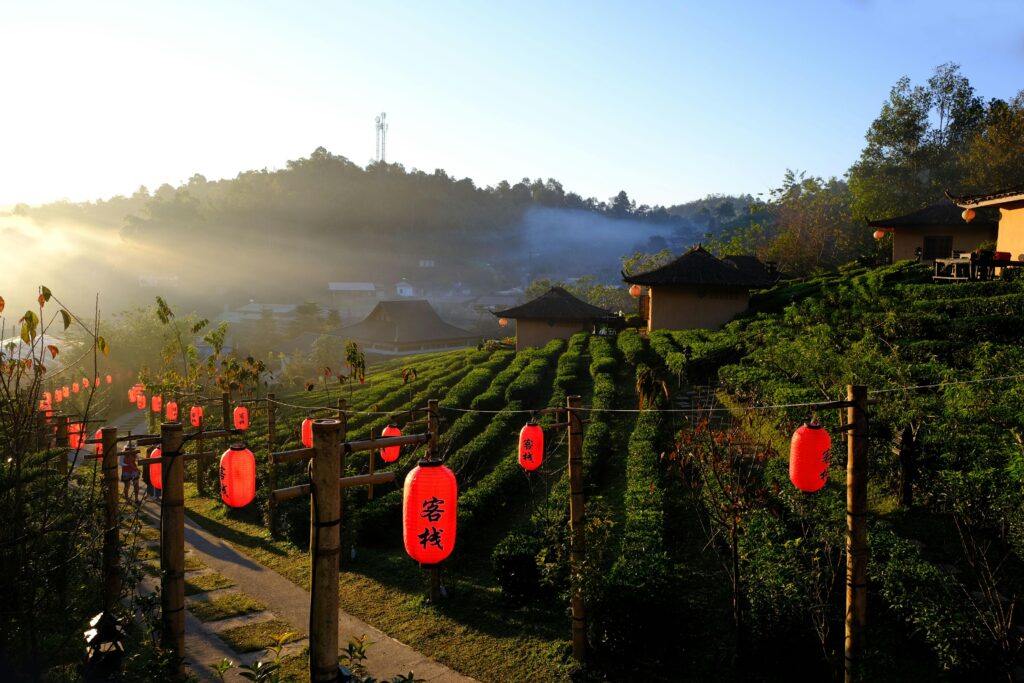
Moving from Vietnam’s tea regions, Thailand has also made impressive strides in oolong production. Thai High Mountain oolongs grow at elevations of 1,200-1,600 meters in the northern highlands, particularly in Chiang Rai and Mae Salong areas.
These regions feature cool climates and misty conditions that create ideal growing environments for tea plants.
Thai oolongs often show a bright, floral character with honey notes that reflect their terroir. Many Thai tea gardens were started by Chinese immigrants who brought traditional processing methods with them.
The resulting teas blend Chinese techniques with distinct Thai growing conditions. Most Thai high mountain varieties undergo light to medium oxidation, creating a fresh taste profile that sits between green and darker oolong styles on the oxidation spectrum.
Indian Oolong Experiments
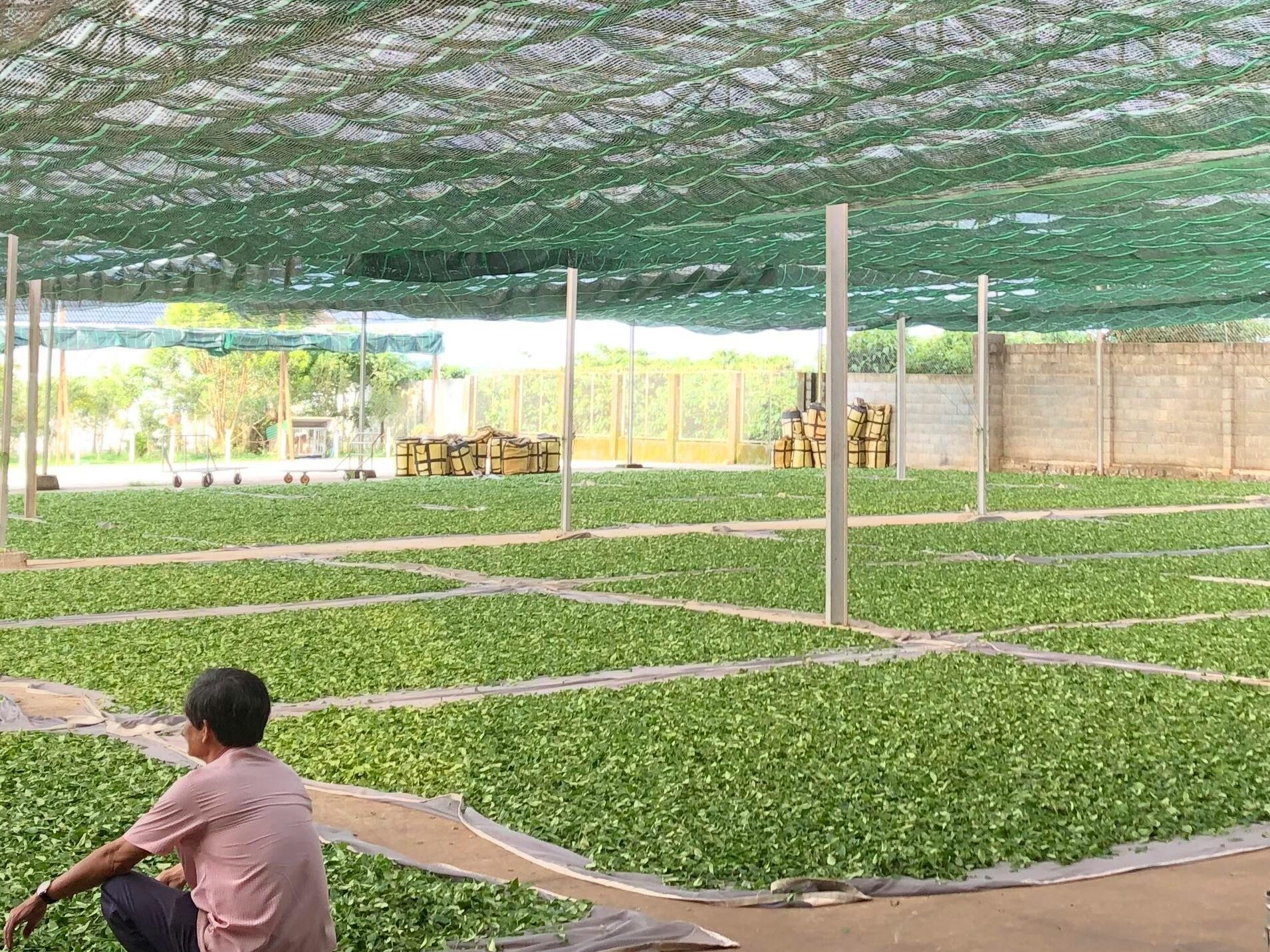
India has carved its own path in oolong tea production, with tea expert Geoffrey F. Norman documenting several notable regions. Darjeeling leads this movement with estates like Phoobsering, Glenburn, and Castleton producing remarkable varieties.
Castleton’s second flush Moonlight oolong stands out for its distinct character that blends muscatel notes with the complexity typical of semi-oxidized teas. These teas offer flavor profiles quite different from their Chinese and Taiwanese cousins.
The oolong adventure extends beyond Darjeeling to other Indian regions. Nilgiri produces the celebrated Nilgiri Frost oolong, which gains its unique taste from the region’s high elevation and winter climate.
In Assam, Mothola estate has pioneered a smoked oolong that combines the region’s malty strength with careful oxidation techniques. Bihar, though less known in tea circles, also contributes to India’s growing oolong portfolio.
Each area brings its local growing conditions and processing skills to create teas that expand the oolong spectrum.
Global Adaptation of Processing
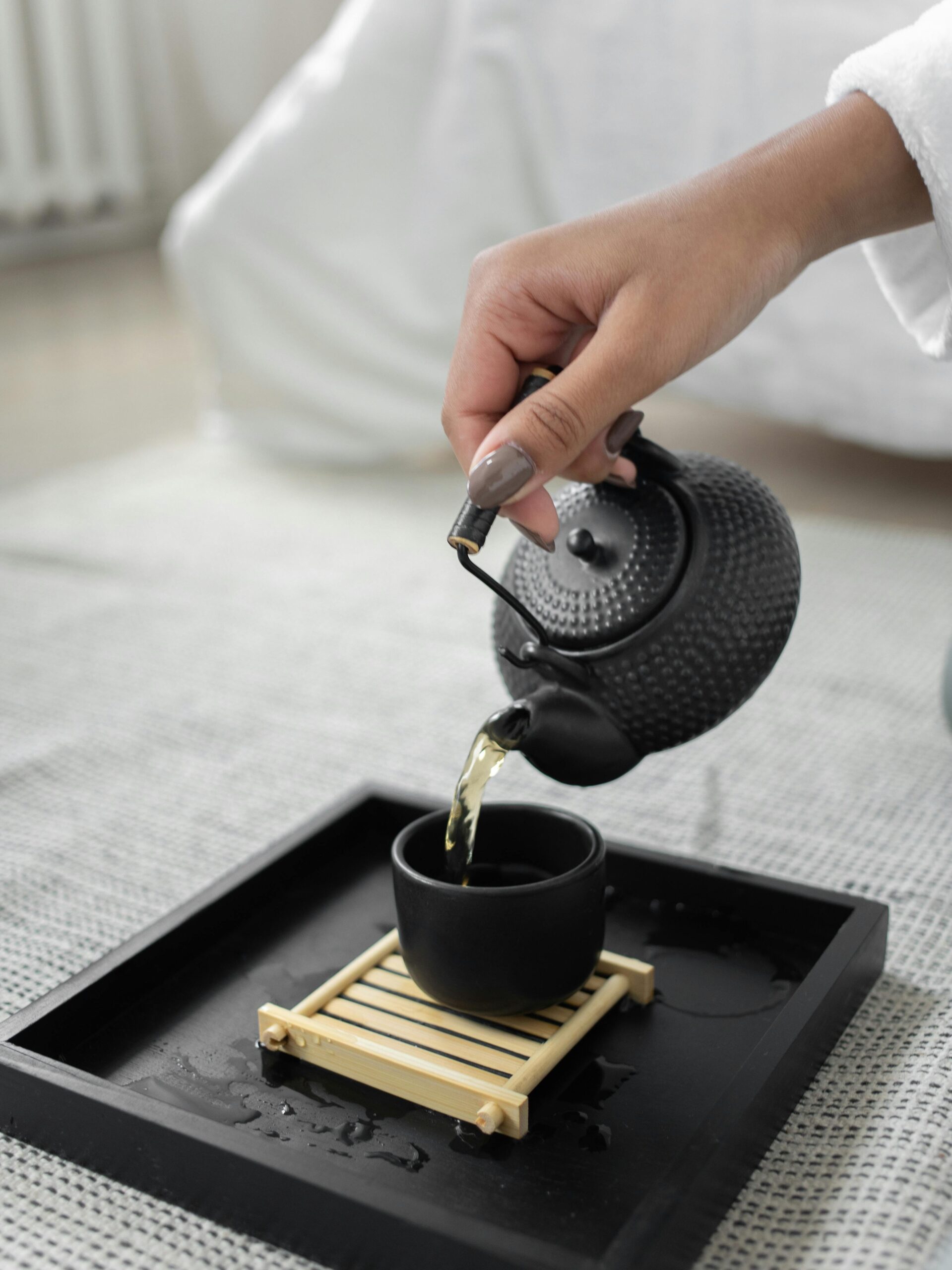
Oolong tea processing has spread far beyond its roots in China’s Fujian province. Tea makers in Vietnam now craft high-mountain oolongs that rival Taiwan’s famous varieties. These artisans adapt traditional methods to local growing conditions while maintaining the 10-80% oxidation range that defines true oolong.
The mineral-rich soils in Vietnam’s highlands produce teas with unique flavor profiles that still honor classic oolong characteristics.
Thai tea producers have embraced oolong cultivation with impressive results. Their high-mountain regions create ideal growing conditions for tea plants that yield floral and sweet notes in the finished product.
Many Thai tea masters trained in Taiwan, bringing back techniques for light oxidation (10-45%) that showcase the tea’s natural fragrance. This knowledge transfer has created a new generation of quality oolongs outside traditional growing regions.
Indian tea gardens have experimented with oolong processing techniques in Darjeeling and Assam. These regions typically known for black tea production now create unique oolongs that blend local tea plant varieties with Chinese processing methods.
The results offer tea drinkers fresh options that combine familiar Indian tea characteristics with the complex flavors that make oolong special. This global spread of oolong crafting enriches the tea world with new expressions of this versatile tea type.
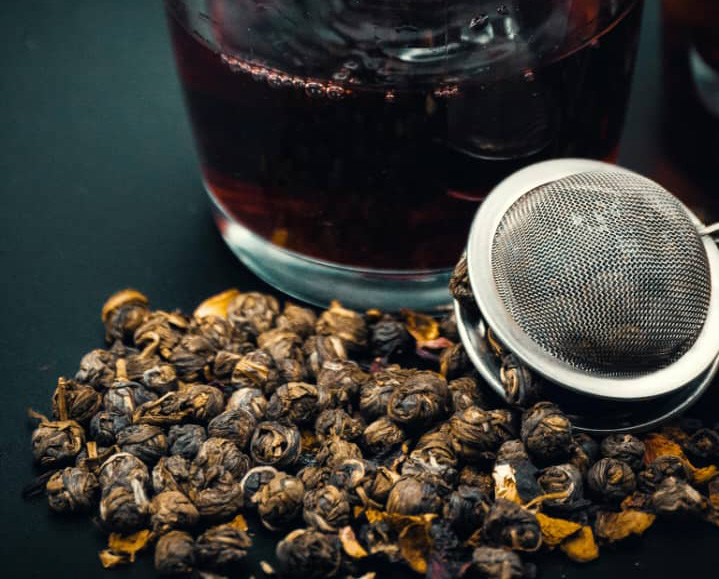
Specialty Categories
Specialty oolong teas offer rare and unique experiences beyond everyday varieties, from single bush Dan Cong with its complex fruit notes to aged oolongs that develop rich, mellow profiles over decades.
Read on to discover these exceptional teas that showcase the pinnacle of tea craftsmanship.
Single Bush Dan Cong
Single Bush Dan Cong represents the pinnacle of Phoenix oolong craftsmanship. These rare teas come exclusively from individual ancient tea trees in Phoenix village, Guangdong, with each tree producing a distinct flavor profile.
Tea masters classify these prized oolongs based on garden altitude, tree age, and flavor qualities. The Lao Cong Wen Zhong variety offers mango and lily notes, while Lao Cong Xiong Di Zhai delivers rich fruity flavors.
Tea enthusiasts prize Lao Cong Song Zhong for its natural peach character that develops without added scents. True Single Bush Dan Congs remain limited in production, making pre-ordering essential before each tea season starts.
Aged Oolongs
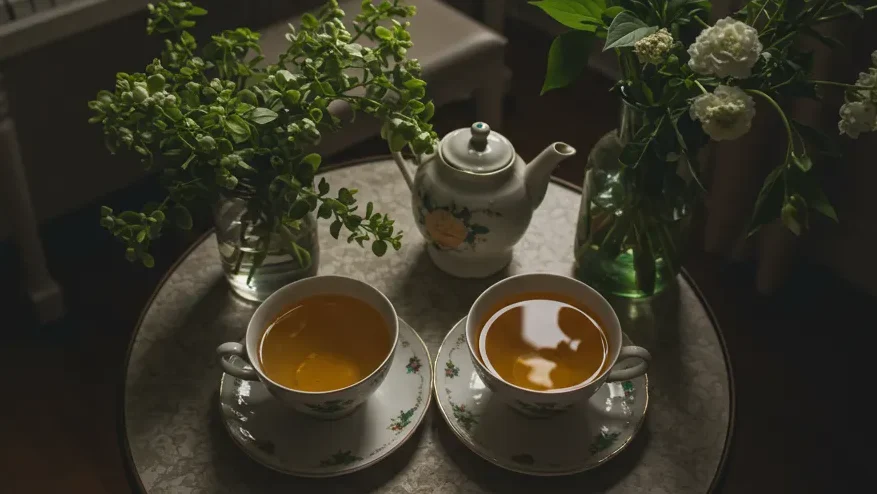
Aged oolongs represent a special category in the tea world, defined as teas that have matured for at least 15 years. Taiwanese rolled oolongs around 6 years old form the backbone of this category, developing smoother profiles as they age.
These teas transform dramatically over time – sharp flavors fade away while richer, deeper notes emerge. Medium-level rolled varieties gain particular complexity, often developing distinctive plum-like flavors that tea enthusiasts prize.
Wuyi Yancha follows a different aging path, typically sold after just 1-2 years of storage. This brief aging period serves a specific purpose: it mellows the strong roast flavors that can dominate the tea’s natural character.
The storage process allows the tea’s inherent qualities to harmonize with the roasting effects. Many collectors store these teas in special containers that protect them while allowing minimal air exchange for proper development.
Tea masters carefully monitor aged oolongs throughout their maturation process, checking for optimal flavor development. The best aged specimens command premium prices at specialty auctions, with some rare examples fetching thousands per pound.
Next, we’ll explore the fascinating world of single bush Dan Cong oolongs, which offer equally impressive complexity through a completely different approach.
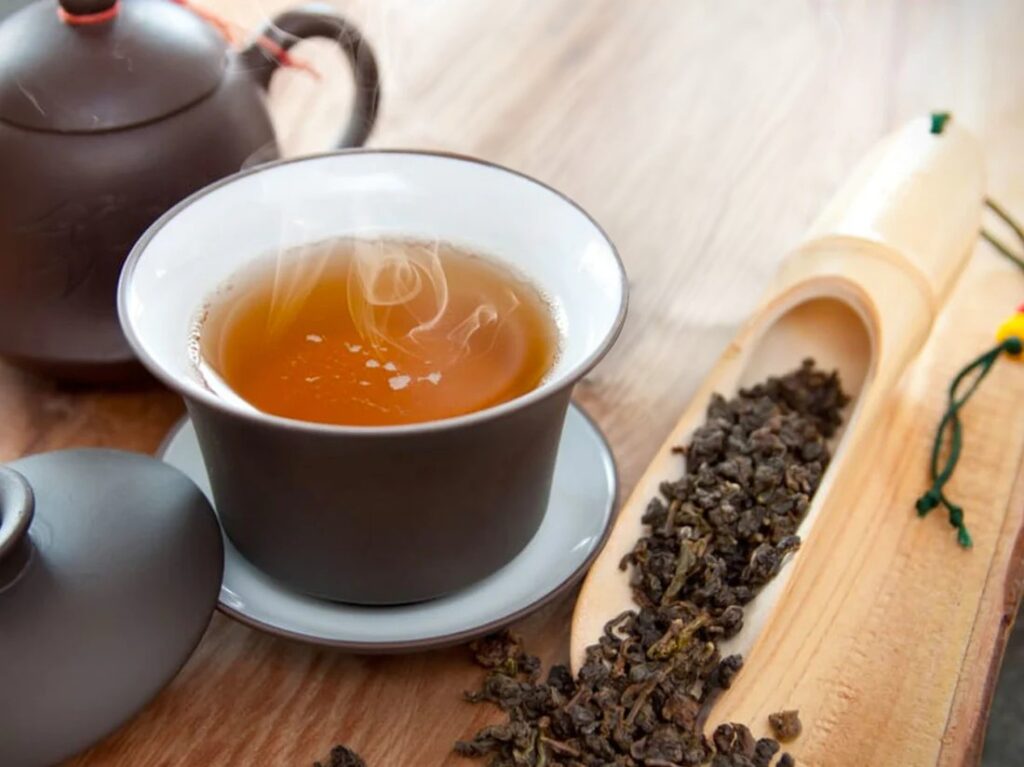
Scented Oolongs
Scented oolongs offer tea lovers a unique twist on traditional varieties. These teas combine the complex character of semi-oxidized leaves with natural fragrances from flowers or fruits.
Jasmine remains the most popular scenting agent, where tea makers layer fresh blooms with processed oolong leaves. The flowers release their essential oils during overnight rest periods, then artisans remove them before packaging.
This technique creates a tea that balances floral notes with the rich, toasty qualities that make oolong special.
Osmanthus oolong stands out as another prized option in this category. Tea masters pair sweet-smelling osmanthus flowers with medium-oxidized oolongs like Tie Guan Yin to create a honey-like aroma that enhances the tea’s natural flavor profile.
Modern producers have expanded beyond traditional scenting methods to include orange blossom, rose, and even fruit-scented varieties. These teas provide an accessible entry point for new oolong drinkers while still maintaining enough depth to satisfy experienced tea enthusiasts.
Competition Grades
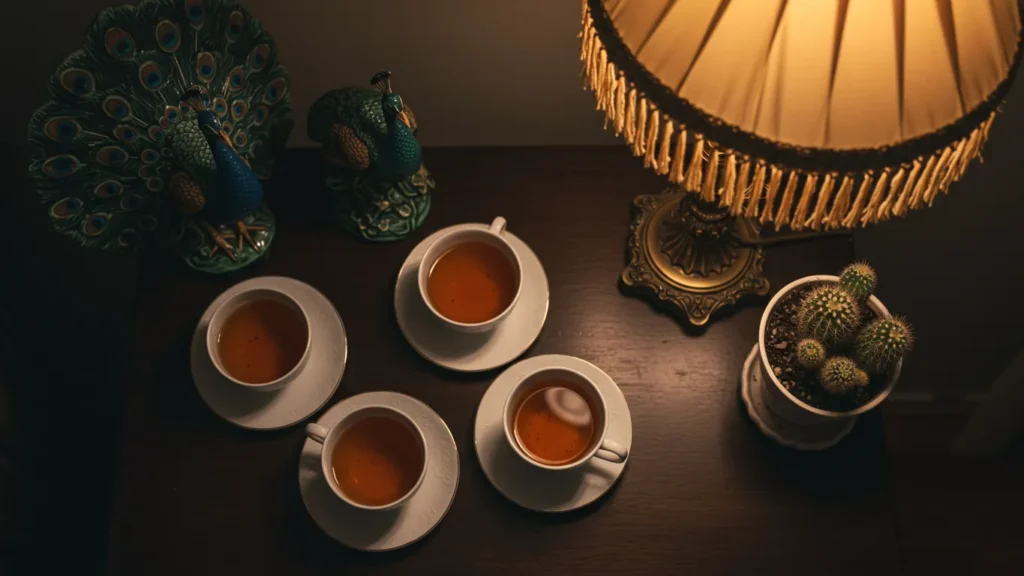
Tea competitions elevate oolong tea to art form status, with farmers submitting their finest harvests for expert evaluation. These contests, held in Taiwan and China’s Fujian province, grade teas on aroma, leaf appearance, liquor color, and taste complexity.
Competition-grade oolongs often sell for premium prices, sometimes reaching hundreds of dollars per ounce for gold medal winners.
The scoring system typically ranges from 0-100, with only the top 10% earning special recognition. Dong Ding and High Mountain varieties frequently dominate these events. Tea masters can identify competition-worthy leaves through careful examination of the tea’s oxidation level, roast quality, and flavor profile.
Buying these award-winning teas gives you access to the absolute peak of oolong craftsmanship.
Modern Craft Styles
Craft oolong producers now blend traditional methods with new techniques to create unique flavor profiles. Many artisans experiment with oxidation levels between the typical ranges, creating teas that showcase both floral notes and deeper roasted elements in the same cup.
Small-batch processing allows tea makers to control every step, from precise leaf picking times to custom roasting curves that bring out specific flavor compounds.
These innovative approaches often result in limited edition teas that change with each season. Producers might use specialized equipment like temperature-controlled roasters or modified withering techniques to achieve specific results.
Some craft styles incorporate unusual finishing steps, such as brief exposure to fruit essences or extended rest periods in special ceramic containers. The best modern craft oolongs maintain respect for tea traditions while pushing boundaries of what oolong tea can be.
Understanding Tea Quality & Tasting

Discover how to spot top-grade oolong tea through color, aroma, and taste markers that reveal its true quality. Learn to train your palate to catch subtle notes from floral to fruity, and grasp what those fancy labels on tea packages really mean.
Read more to master the art of oolong tea tasting and make smarter choices for your tea collection.
How to Choose Quality Oolong
Quality oolong tea offers a world of complex flavors with ratings often reaching 4.8 out of 5 stars. Finding the best oolong requires attention to several key factors that signal superior tea leaves.
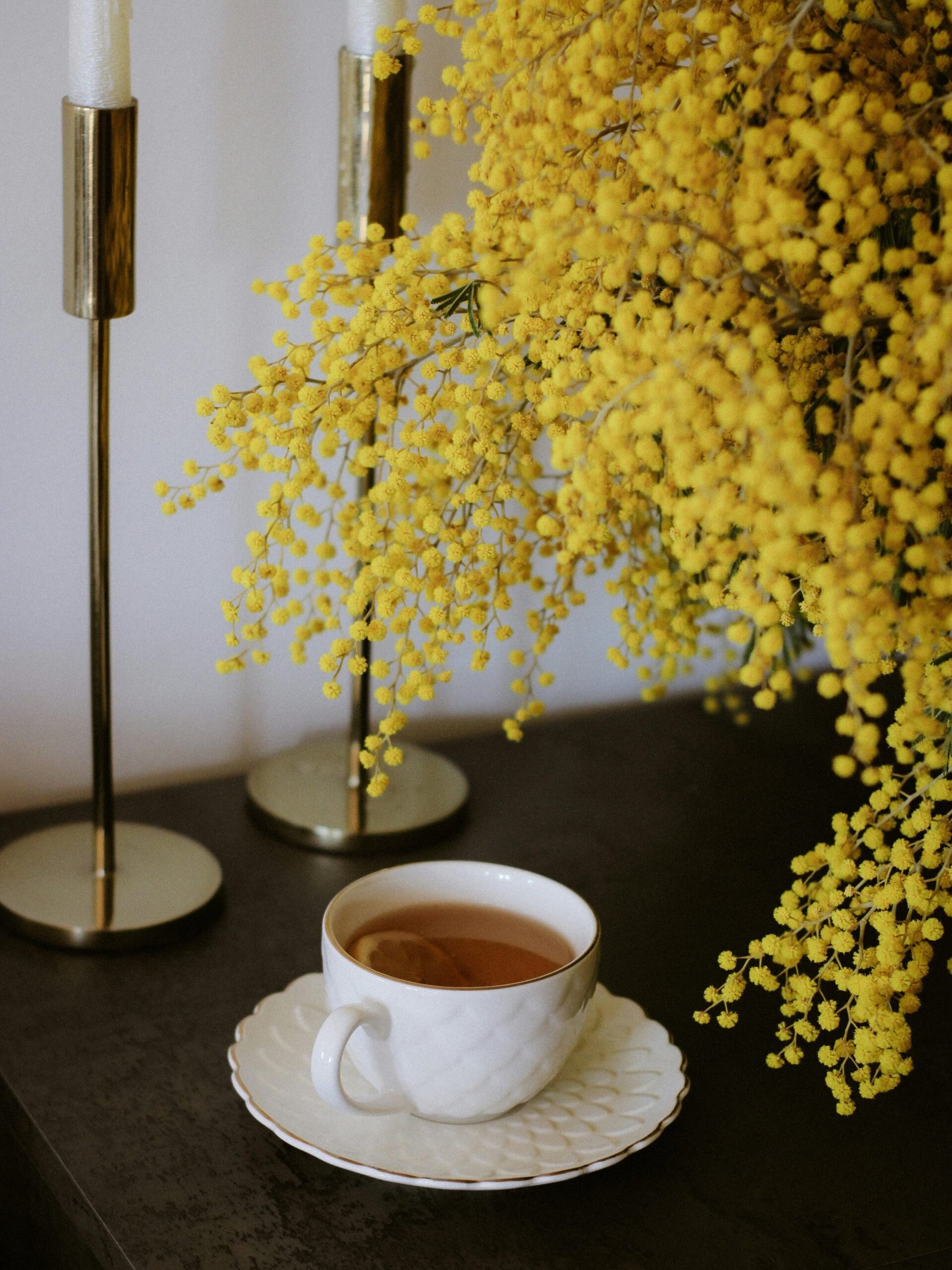
- Check the leaf appearance for whole, unbroken leaves that show careful processing. High-quality oolong leaves should look twisted or rolled, with consistent coloring throughout the batch.
- Notice the aroma of dry leaves, which should smell fresh and fragrant without any musty or stale notes. The best oolongs release complex scents ranging from floral to fruity or roasted, depending on their oxidation level.
- Examine the oxidation level, which ranges from 20% to 80%, creating the wide flavor spectrum unique to oolong tea. Light oxidation produces more floral notes, while higher oxidation creates deeper, fruitier profiles.
- Look for clear origin information that specifies the exact growing region like Fujian, Taiwan, or Guangdong. Premium oolongs often come from specific mountains or gardens with established reputations.
- Test the leaf expansion during brewing, as quality oolong unfolds into full leaves rather than breaking apart. Good oolong leaves can expand to three times their dry size.
- Assess the tea liquor clarity, which should be bright and clear without cloudiness or particles. The color varies from pale gold to amber depending on oxidation and roasting levels.
- Taste for complexity and multiple flavor notes that evolve across infusions. Superior oolong delivers layers of taste rather than a single dominant flavor.
- Consider harvest timing, with spring harvests typically commanding higher prices due to their balanced flavor profiles. Seasonal variations affect the character of the tea significantly.
- Brew at the proper temperature – typically 80-90°C (175-195°F) for light oolongs and 90-100°C (195-212°F) for darker, more oxidized varieties – to evaluate quality fairly. Poor brewing can mask the true character of even the finest oolong varieties.
- Try multiple infusions, as quality oolong should maintain its flavor through several steepings. The Gong Fu Cha method highlights this quality by emphasizing multiple short infusions.
- Verify freshness, as most oolongs taste best within one year of production unless specifically aged. Fresh oolong has vibrant flavors that diminish over time.
- Ask about processing methods, since traditional charcoal roasting often indicates higher craftsmanship than electric roasting. The roasting technique greatly impacts the final flavor profile.
- Compare prices across vendors, as extremely cheap oolong often signals lower quality leaves. Premium oolong justifies higher costs through superior taste and multiple infusions.
Developing Your Oolong Palate
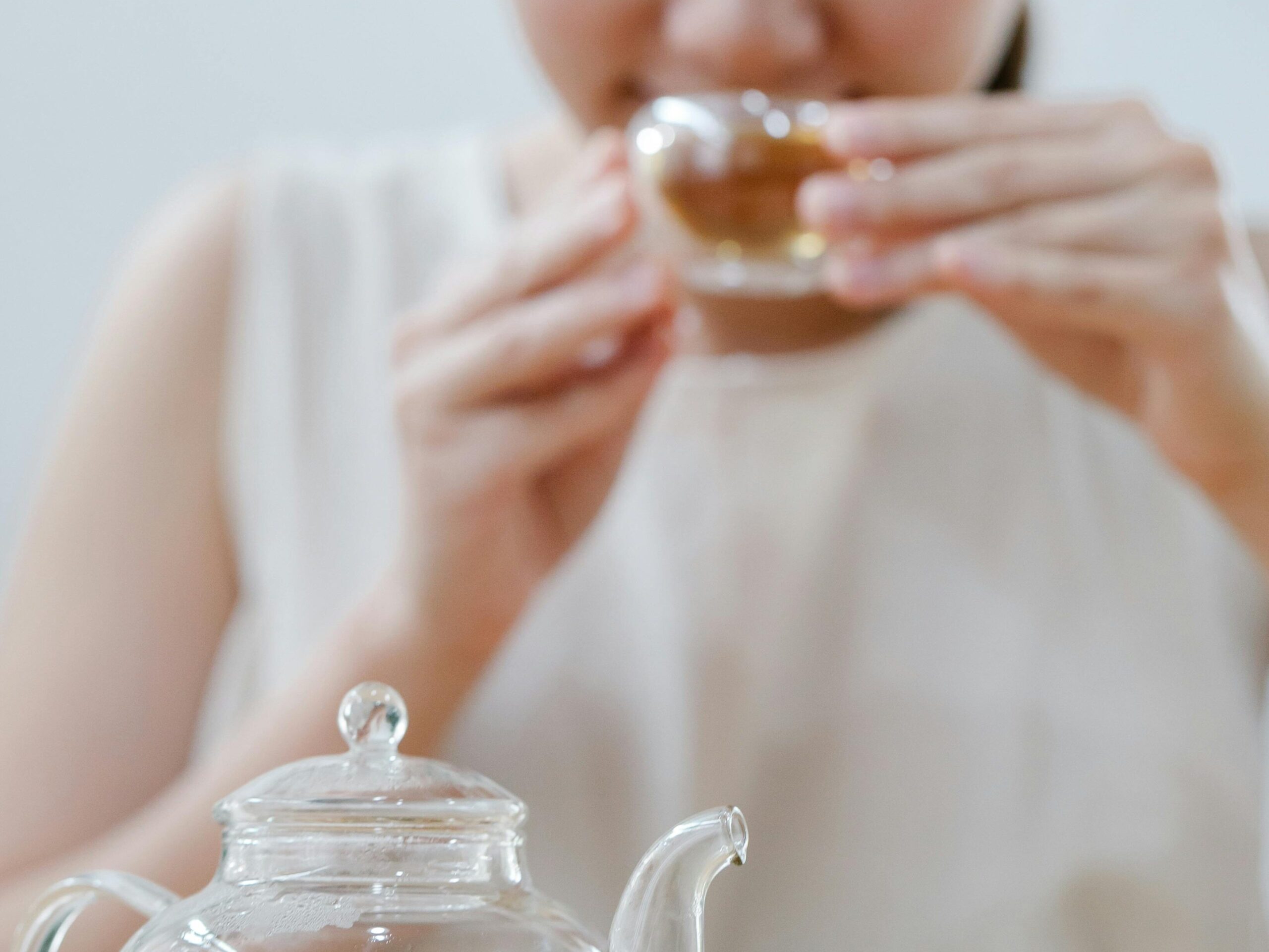
Training your taste buds to appreciate oolong tea takes time and practice. Your palate can learn to detect subtle flavor notes that make each oolong variety special.
- Start with different types of oolong tea to understand the wide flavor range from floral and fruity to deep chocolate and creamy nuts.
- Taste teas side by side to spot differences between light, medium, and heavy oxidation styles.
- Focus on mouthfeel first, noting how the tea feels – silky, thick, thin, or brisk on your tongue.
- Pay attention to the finish, which is how long flavors last after you swallow the tea.
- Try brewing the same tea at different water temperatures to see how heat affects flavor.
- Sample oolongs from Fujian, Taiwan, and Guangdong to learn how terroir shapes taste.
- Keep a tasting journal with notes about each cup of oolong you drink.
- Learn basic tasting terms like astringent, brisk, malty, and floral to describe what you taste.
- Adjust steeping times to extract different flavor layers from the same tea leaves.
- Use proper equipment such as a gaiwan or small teapot to control the brewing process.
- Cleanse your palate between tastings with plain water or mild crackers.
- Taste with friends who can point out flavors you might miss in your cup of oolong.
- Explore aged oolongs to understand how time transforms tea flavors.
- Compare spring and fall harvests of the same tea to detect seasonal differences.
- Study the leaf appearance before brewing to connect visual cues with taste expectations.
- Practice describing flavors without looking at the tea packaging or marketing materials.
- Develop sensitivity to roast levels by comparing charcoal-roasted versus electric-roasted teas.
- Test how water quality impacts the final taste of your brewed tea.
- Notice how the aroma changes from dry leaf to wet leaf to the actual tea liquor.
- Build a reference library of flavor memories from fruits, flowers, and spices to help identify notes in tea.
Tasting Notes and Evaluation

Oolong teas offer a vast landscape of flavors waiting to be discovered. Learning to taste and evaluate these complex teas helps you appreciate their unique qualities and find varieties that match your preferences.
- Look at the dry leaves first – quality oolong often has tightly rolled or twisted leaves with consistent coloring and minimal broken pieces.
- Notice the aroma of dry leaves which reveals early clues about oxidation level – lighter oolongs smell fresh and floral while darker ones offer roasted, woody notes.
- Examine the wet leaves after steeping as they should unfurl fully and display vibrant colors without excessive tearing or damage.
- Assess the tea liquor color ranging from pale yellow-green (light oolong) to amber or deep reddish-brown (dark oolong).
- Taste the tea at different temperatures since flavor compounds release at various heat levels – start hot and note how flavors change as it cools.
- Focus on the initial taste impact which might include floral notes in high mountain varieties or fruity qualities in Dan Cong oolongs.
- Pay attention to mouthfeel characteristics like smoothness, thickness, or astringency that vary between processing styles.
- Identify specific flavor notes using common descriptors such as orchid, honey, peach, roasted nuts, or caramel.
- Evaluate the finish and aftertaste (known as “hui gan” in Chinese tea culture) which can linger pleasantly for minutes after swallowing.
- Judge the tea’s complexity by noting how flavors evolve from first sip through multiple infusions.
- Compare the balance of sweetness, acidity, bitterness, and astringency which should complement rather than overwhelm each other.
- Test multiple steepings since quality oolong maintains rich flavors across several infusions – premium teas might yield 5-8 flavorful cups.
- Record your observations in a tea journal using consistent terminology to track preferences over time.
- Rate overall satisfaction based on personal preference rather than just technical quality markers.
- Consider seasonal variations as tea harvested in spring often differs from autumn pickings of the same variety.
Understanding Grades and Labels
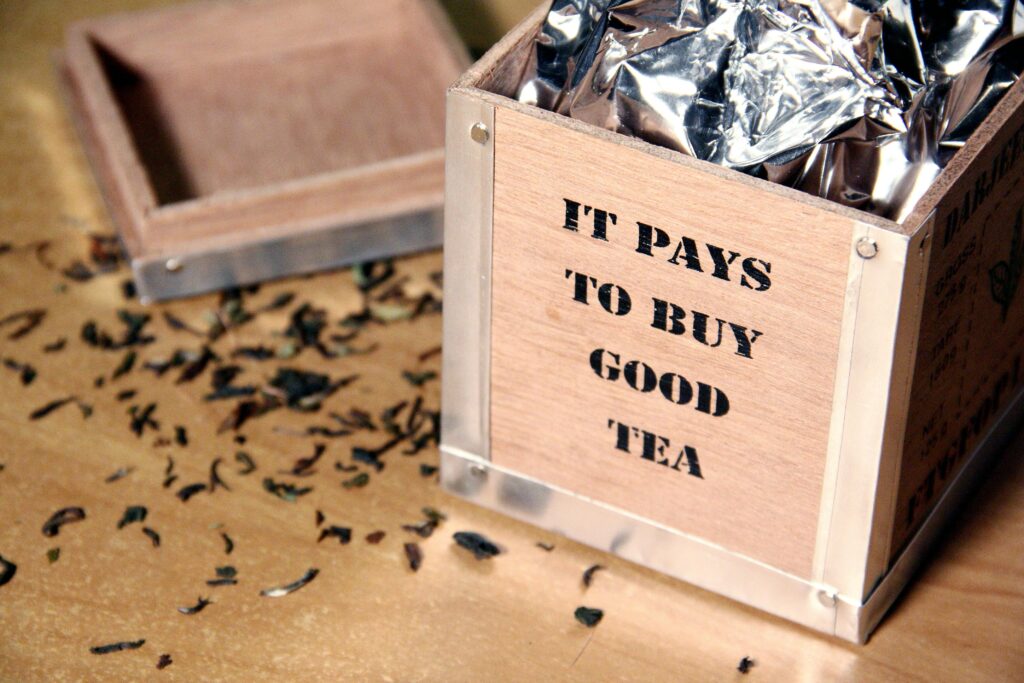
Oolong tea labels often display grades that signal quality levels. These grades vary by region – Taiwan uses terms like “Premium,” “Superior,” and “Choice,” while Chinese producers might label teas as “AAA,” “AA,” or “A.” The highest grades typically come from early spring harvests with tender leaves and buds.
Many labels also note the elevation, with high mountain (gaoshan) teas from Taiwan commanding top prices due to their complex flavors.
Tea packaging may include harvest dates, oxidation levels, and roast intensity. Fresh green oolongs might say “light oxidation” or “qing xiang” (fresh fragrance), while darker styles could be marked “traditional roast” or “nong xiang” (rich fragrance).
Some premium teas feature competition grades such as “Gold Medal” or specific scores from tea contests. The most valuable Dan Cong oolongs list the exact cultivar name like “Mi Lan Xiang” (honey orchid fragrance) or “Ya Shi Xiang” (duck shit fragrance).
AI-generated image of tea leaves with labels and grades.
Optimal Storage Practices
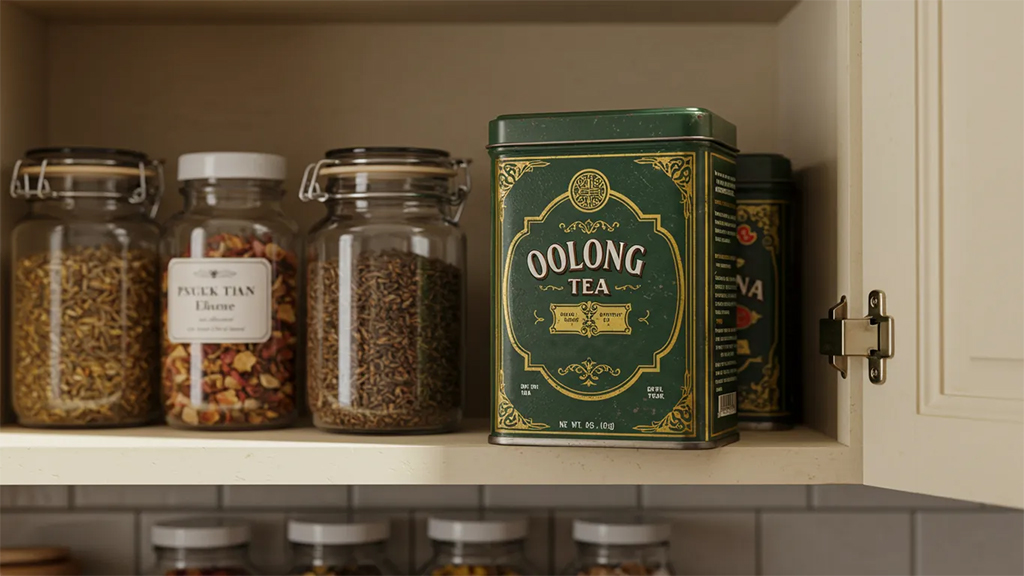
Proper storage makes all the difference in maintaining your oolong tea’s quality. Airtight containers shield tea leaves from their greatest enemies: air and moisture. Glass jars with rubber seals or metal tins designed specifically for tea work best to preserve those complex flavors that make oolong special.
The container should also be opaque to block light, which can break down the delicate compounds in your tea leaves over time.
Location matters just as much as the container itself. Keep your tea away from the kitchen sink, stove, or refrigerator where moisture levels fluctuate. A cool, dark cabinet away from spices and strong odors provides the ideal home for your tea collection.
Direct sunlight and heat speed up deterioration, so avoid windowsills or shelves near heating vents. Even premium varieties like Iron Goddess or Dong Ding will lose their distinctive character if stored improperly.
Fresh oolong tea delivers the best flavor experience, so try to enjoy it within 6-12 months of purchase. Many tea enthusiasts date their containers to track freshness. Some specialty oolongs like aged varieties actually improve with time, but most types taste best when relatively fresh.
The storage clock starts ticking from the moment the tea leaves finish processing, not from when you open the package, so buying in smaller quantities often results in better tea drinking experiences.
Advanced Brewing Techniques
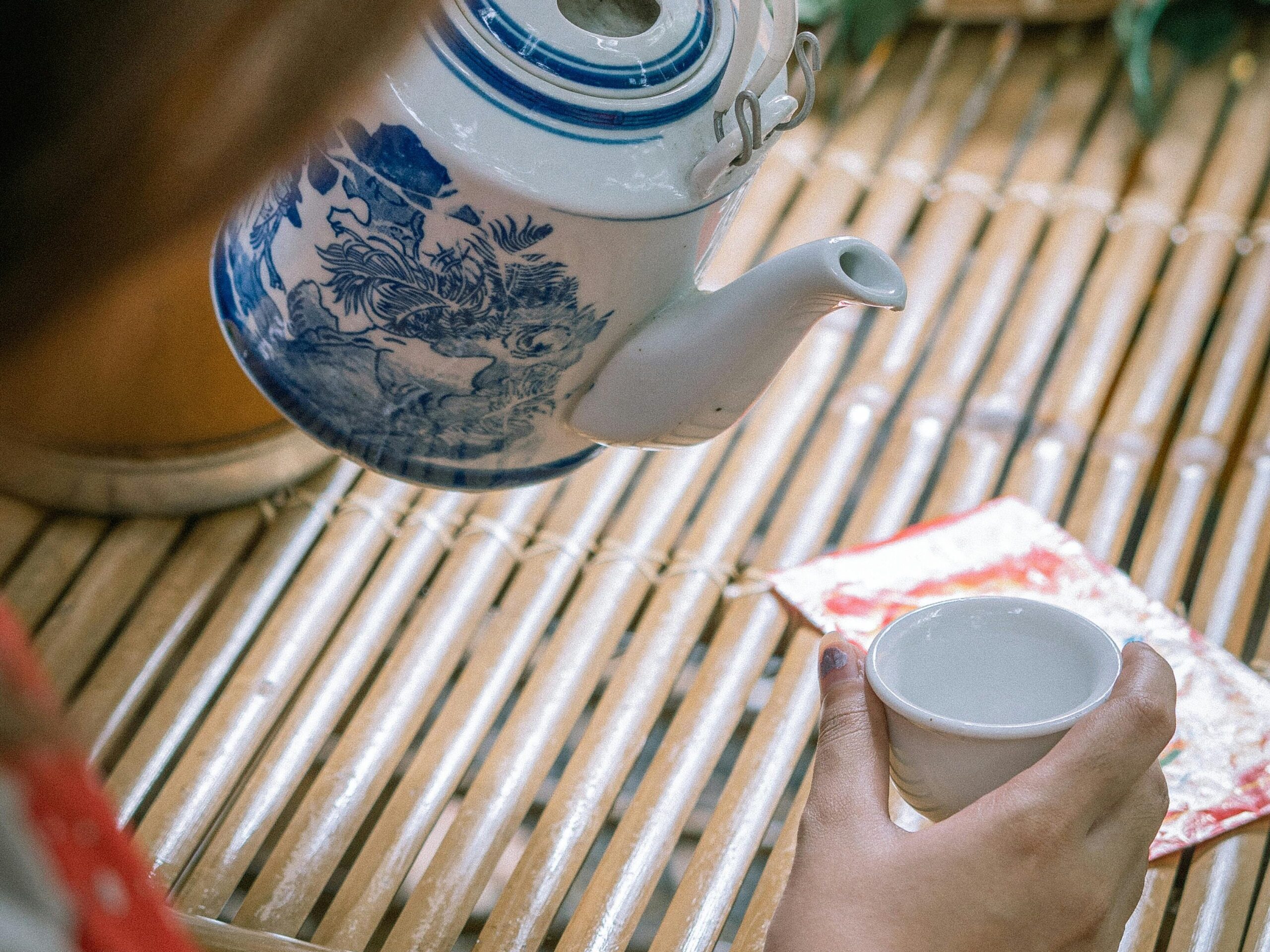
Mastering oolong tea brewing demands skill with water temps, steep times, and special tools like gaiwans or clay teapots – discover how these methods unlock hidden flavors in your favorite varieties!
Temperature and Time Control
Perfect oolong tea requires exact temperature and timing for each variety. Your brewing skills will improve once you master these two critical elements.
- Light oolong teas need water between 175-185°F (80-85°C) to preserve their delicate floral notes and prevent bitterness.
- Medium oxidation oolongs perform best with slightly hotter water at 185-195°F (85-90°C) to extract their complex flavor profile.
- Dark, heavily oxidized oolongs require the hottest water at 195-205°F (90-96°C) to fully release their rich, roasted character.
- Digital thermometers offer the most accurate temperature readings for serious tea enthusiasts seeking precision.
- Steeping time varies significantly based on oxidation level – light oolongs need only 1-2 minutes while dark varieties require 3-5 minutes.
- Short steeps work better for high-quality loose leaf tea, allowing multiple infusions that reveal different flavor aspects.
- Tea leaves expand during brewing, so always use containers that give them space to unfurl completely.
- Water quality affects extraction – filtered water without excessive minerals creates a cleaner taste profile.
- Gongfu brewing methods use higher leaf-to-water ratios with shorter steep times for more intense flavor.
- Altitude affects water’s boiling point, so brewing guides may need adjustment if you live in mountain regions.
- The standard measure of 2-3 grams (about one teaspoon) per 8 ounces creates a balanced cup for most oolong varieties.
- Consistent timing matters – even 30 seconds too long can transform a smooth cup into an astringent disappointment.
Let’s explore the specialized equipment that can enhance your oolong tea brewing experience.
Equipment and Water Quality
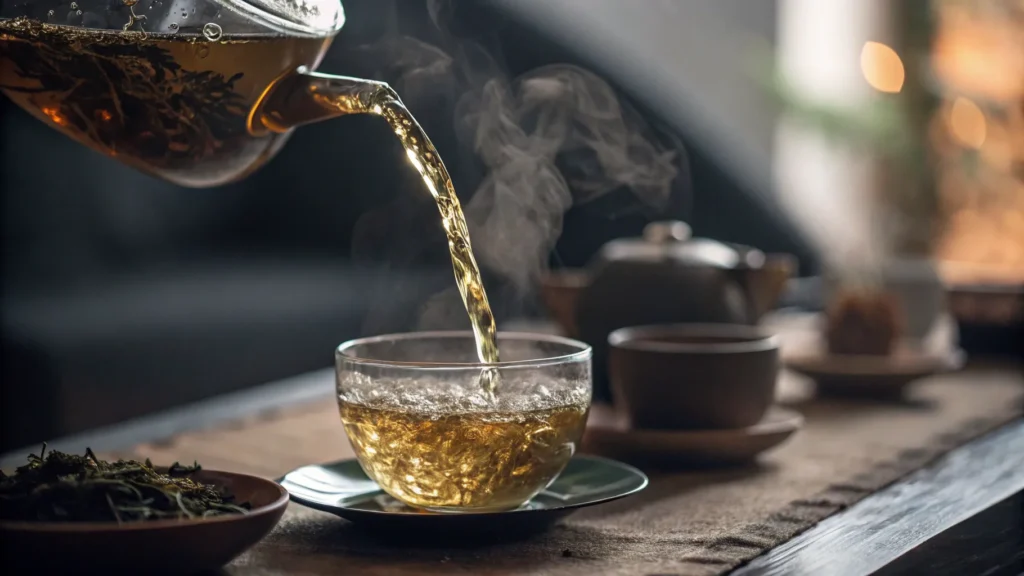
Quality oolong tea demands proper tools for the best results. A gaiwan serves as the ideal brewing vessel because its wide opening allows tea leaves to unfurl fully. This traditional lidded cup pairs perfectly with a serving pot to control steep time and maintain consistent flavor across multiple infusions.
Many tea enthusiasts also use a tea tray to catch spills and create a complete brewing station.
Water quality impacts your tea as much as the leaves themselves. Pure, filtered water brings out subtle notes in high mountain Taiwanese oolongs and rich Wuyi rock teas. The mineral content in your water can enhance or mask certain flavors, especially in delicate varieties like Tie Guan Yin.
Water temperature must stay between 80°C to 90°C for optimal extraction without bitterness. Too hot, and you’ll scorch delicate notes; too cool, and the full flavor profile won’t develop.
Your brewing equipment should match your tea style. Light oxidized oolongs shine in glass or porcelain, while heavily roasted Dan Cong benefits from clay vessels that retain heat. The right tools transform loose leaf oolong from ordinary to extraordinary, revealing complex layers with each steep.
Multiple infusion techniques require precise timing to capture the evolving character of each tea variety.
Multiple Infusion Techniques

The right equipment sets the stage for perfect oolong tea, but mastering multiple infusions unlocks its full potential. Oolong tea leaves can be steeped several times, with each infusion revealing new flavors and aromas.
- First infusion requires a quick rinse of the leaves with hot water (180-200°F / 82-93°C) for about 5 seconds to wake up the leaves.
- Short steeping times work best for initial infusions – try 30 seconds for the first proper steep to capture delicate floral notes.
- Add 10-15 seconds to each subsequent infusion to extract deeper flavors as the leaves fully open.
- High-quality oolong teas can yield 5-8 infusions, with premium varieties offering up to 12 flavorful steeps.
- Lighter oxidized oolongs like Tie Guan Yin often reveal sweet, floral notes in early infusions that transform into richer, creamier profiles later.
- Dark oolongs such as Wuyi Rock teas develop from mineral-forward first infusions to fruity, caramel-like notes in middle steeps.
- Temperature adjustments between infusions can highlight different aspects – slightly cooler water brings out sweetness while hotter water extracts deeper notes.
- The color change between infusions serves as a visual guide – watch as it shifts from pale gold to amber or deep orange depending on the tea type.
- Taiwanese high mountain oolongs often peak at the third or fourth infusion, where their signature creamy mouthfeel fully develops.
- Milk oolong varieties require special attention – their buttery notes emerge most prominently around the second or third infusion.
- Gongfu brewing method maximizes the multiple infusion experience through its precise control of water-to-leaf ratio.
- Taste comparison between infusions helps develop your tea palate and appreciation for the complexity of oolong tea.
Gongfu Brewing Method
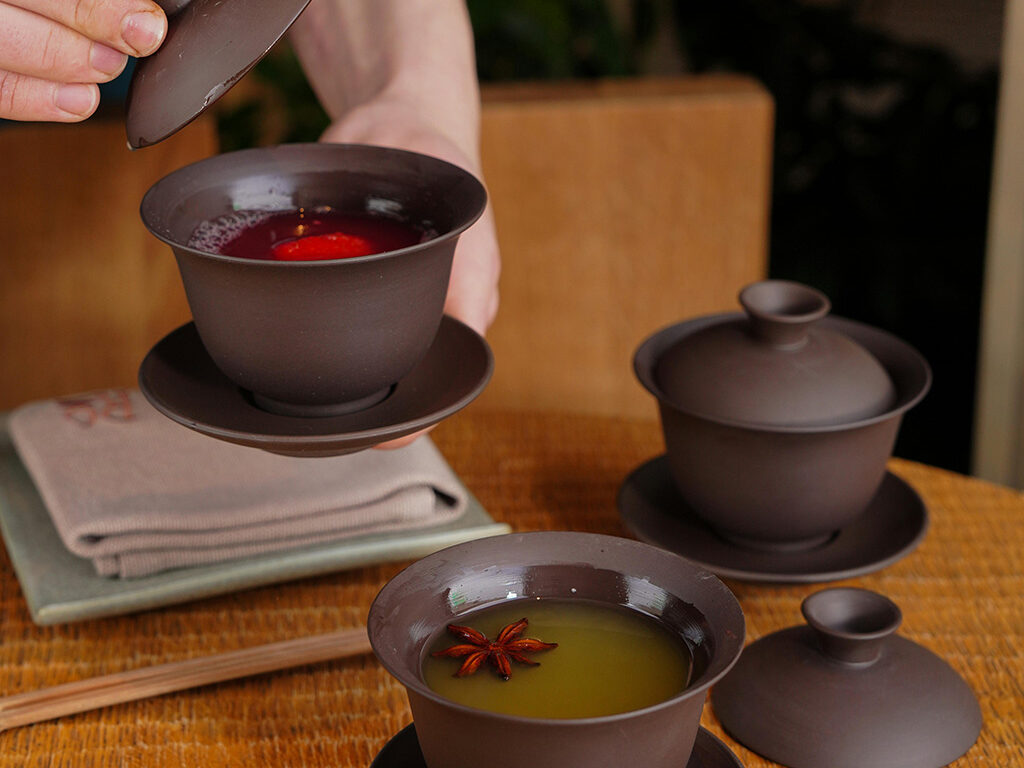
Gongfu brewing transforms ordinary tea into an extraordinary experience through precise methods and careful attention. This traditional Chinese approach brings out complex flavors that casual brewing methods often miss.
- Gongfu brewing originated in Chaozhou, Guangdong Province, over a century ago as a way to maximize tea flavor.
- Small clay teapots or gaiwans (lidded cups) work best for this method since they retain heat well and allow full leaf expansion.
- Tea masters use a high leaf-to-water ratio—typically 1 gram of tea per 15ml of water—much stronger than Western brewing styles.
- Water temperature matters greatly in gongfu preparation, with most oolong teas requiring water between 190-205°F for optimal extraction.
- Short steeping times distinguish this technique, often starting at just 10-20 seconds for the first infusion.
- Each subsequent infusion increases slightly in duration to extract different flavor compounds as the leaves unfold.
- Multiple infusions—sometimes up to 10 or more—reveal how the tea’s character changes with each steep.
- Proper tools enhance the experience: a brewing vessel, serving pitcher, strainer, cups, and tea tray for collecting spilled water.
- Warming all vessels before brewing prevents temperature drops that affect flavor development.
- Rinsing the leaves briefly with hot water before the first proper infusion awakens the tea and removes any dust.
- Focused attention during brewing creates a meditative practice that connects you deeply to the tea’s qualities.
- Tea appreciation becomes more nuanced through gongfu brewing as you notice subtle changes across infusions.
- Aroma cups sometimes accompany this method, allowing you to experience the fragrance separately from the taste.
- Gongfu literally means “making tea with skill,” emphasizing the craftsmanship involved in proper preparation.
- This brewing style particularly suits premium oolongs like Tie Guan Yin and Wuyi rock teas, revealing their complex character.
The Culture of Oolong Tea
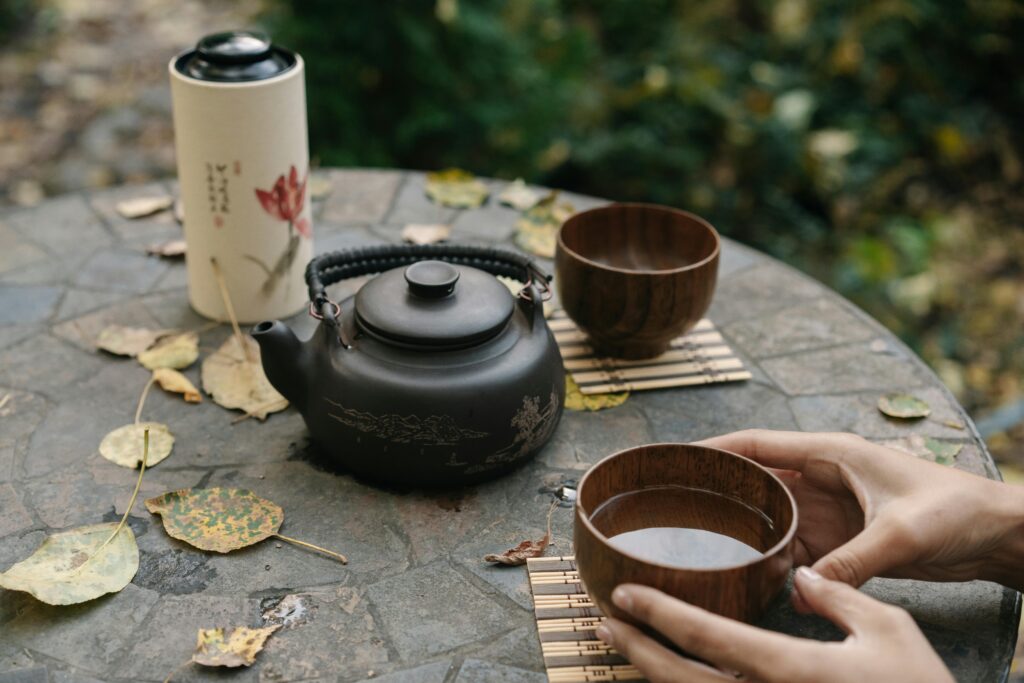
Oolong tea rituals bring families together across generations in China and Taiwan, where tea houses serve as social hubs for business deals and friendly chats. Tea masters spend decades perfecting brewing methods that honor centuries-old traditions while adapting to modern tastes and global tea trends.
Historical Significance
Oolong tea holds deep roots in Chinese culture, dating back to the Ming Dynasty (1368-1644). This special tea emerged as a distinct style during this period, creating a bridge between green and black tea processing methods.
Tea masters in Fujian Province developed unique techniques that allowed partial oxidation, giving birth to what we now call oolong.
The British East India Company played a major role in bringing oolong tea to Western markets during the 18th and 19th centuries. Ships loaded with tea leaves traveled across oceans, introducing these complex flavors to European tea drinkers.
This trade helped spread Chinese tea culture globally and established oolong as a premium tea category. Taiwan later became another important center for oolong production, developing its own regional styles that gained fame for their quality and unique flavor profiles.
Regional Traditions
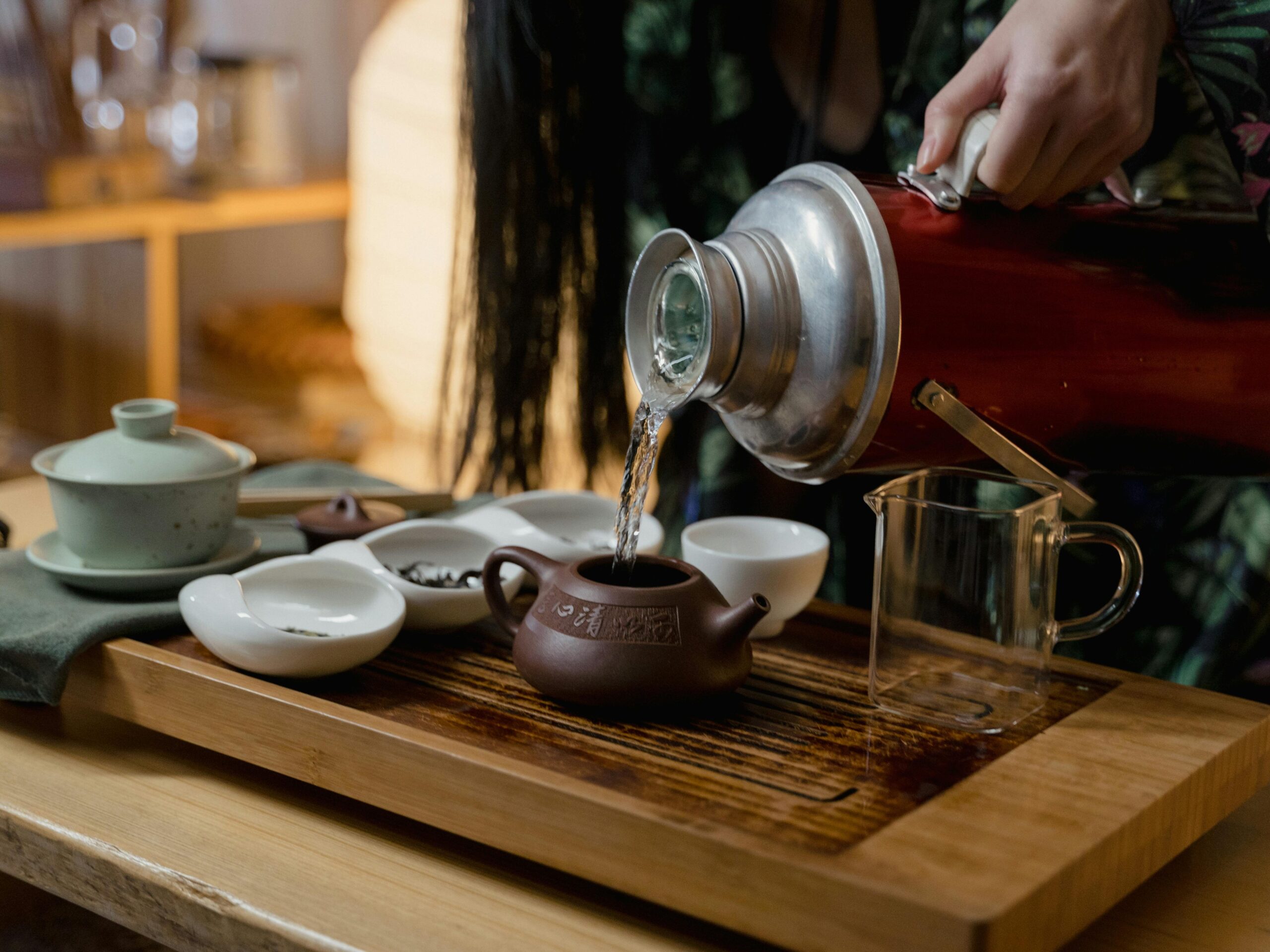
Historical appreciation of oolong tea has evolved into distinct regional customs across Asia. In Fujian Province, tea ceremonies focus on the rich Wuyi rock teas, with locals using small clay pots that enhance the mineral notes of Da Hong Pao.
These gatherings often include multiple steepings to showcase how flavors transform through each pour.
Taiwan’s tea traditions differ notably from mainland China practices. High mountain tea farmers in Taiwan host seasonal tasting events where visitors sample fresh harvests directly at the source.
Phoenix Mountain in Guangdong preserves unique serving customs for their Dan Cong oolongs. Local tea masters use tiny cups to concentrate the tea’s famous floral aromas and teach guests to appreciate the “empty cup fragrance” that lingers after drinking.
Each of these four main oolong regions—Wuyi Shan, Anxi County, Phoenix Mountain, and Taiwan—maintains specific brewing techniques passed through generations that highlight their signature tea characteristics.
Modern Appreciation

Oolong tea enjoys growing popularity among tea lovers worldwide who value its complex flavors and rich traditions. Social media platforms showcase stunning gongfu ceremonies and rare tea varieties, while specialty tea shops in major cities now stock premium Taiwanese high mountain oolongs and classic Wuyi rock teas.
Tea enthusiasts gather at tastings and festivals to sample different styles of oolong, from the floral notes of lightly oxidized varieties to the deep, roasted character of heavily processed types.
The unique sweet aftertaste and lingering fragrance that distinguish quality oolongs have sparked interest beyond traditional tea markets.
Tea culture has evolved with modern brewing tools designed specifically for oolong preparation. Many tea drinkers invest in proper teaware like clay pots, gaiwans, and temperature-controlled kettles to extract the full range of flavors from their tea leaves.
Online communities share brewing tips and tasting notes, helping newcomers appreciate the differences between Dan Cong varieties or Taiwan’s prized Dong Ding teas. This global interest has encouraged farmers to maintain traditional processing methods while experimenting with new techniques to meet changing tastes and preferences.
Collecting and Aging Practices

Beyond modern appreciation lies the art of collecting and aging oolong teas. Tea enthusiasts often build collections of premium oolongs specifically for aging, as these teas transform beautifully over time.
Many collectors store their prized Tieguanyin and Wuyi varieties in clay vessels, which allow the tea to breathe while protecting it from light and moisture. The aging process typically requires patience – at least three years for noticeable changes, with 10-20 years considered the sweet spot for optimal flavor development.
Serious collectors may practice annual re-roasting of their aged teas to maintain quality and prevent unwanted moisture absorption. This technique helps preserve the tea’s character while allowing it to develop deeper, more complex notes over time.
Unlike the well-known aged pu-erh teas, aged oolongs remain somewhat under-appreciated in Western markets despite their remarkable transformation. The aging process reduces astringency while introducing honey, fruit, and woody notes that simply don’t exist in fresh oolong tea leaves.
Conclusion
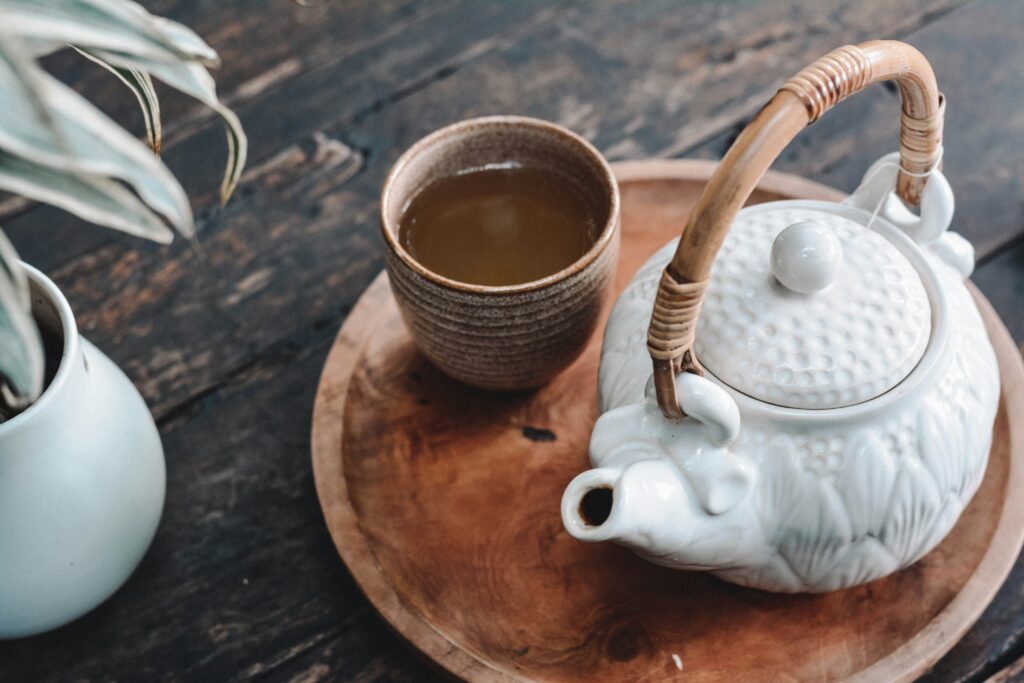
Oolong tea offers a vast range of flavors from light floral notes to rich roasted profiles. Each variety tells a story through its unique processing methods and regional characteristics.
Taiwan’s high mountain teas deliver crisp, sweet notes while Fujian’s rock teas present deep, mineral-rich flavors. The best oolong depends on your taste preferences—whether you enjoy the delicate qualities of lightly oxidized teas or the bold character of heavily roasted varieties.
Your journey through oolong tea types will reward you with some of the most complex and satisfying tea experiences available.
FAQs
1. What makes oolong tea different from other tea types?
Oolong tea sits between fresh green tea and malty black tea in the oxidation process. The technique of the tea master determines how oxidized oolong tea becomes, giving the tea leaves their unique character. This category of tea offers complex flavors that can vary from light and floral to dark and roasted.
2. Which are the most famous varieties of oolong tea?
The most celebrated types include Iron Goddess of Mercy (Tie Guan Yin) from Anxi, Wuyi tea from China’s rocky cliffs, and Jin Xuan milk oolong from Taiwan. These Chinese oolong teas represent the historical centers of oolong production and showcase the world of oolong at its finest.
3. How do I prepare oolong tea correctly?
Use water just below boiling point and steep for 1-3 minutes. The tea is usually ready when the leaves have partially unfurled. For darker oolong teas, you can steep slightly longer.
4. What health benefits does oolong tea offer?
Oolong tea is naturally rich in antioxidants that may help with weight loss and reduce risks of cardiovascular disease. Studies suggest it might also help fight tooth decay and dental plaque. The tea can also support cell health due to its unique compounds.
5. Where did oolong tea come from originally?
Oolong tea came from China centuries ago, with Fujian Province and Taiwan’s tea regions becoming the primary sources. The story of tea includes legends about dragon-phoenix tea and how oolong produced its distinctive character through special processing methods.
6. Can I add milk or sugar to oolong tea?
While purists enjoy oolong without additions to appreciate its natural flavors, you can add a touch of sugar if desired. Unlike black Assam tea, most oolong varieties don’t pair well with milk as it masks the tea’s delicate notes.
References
- https://en.wikipedia.org/wiki/Oolong
- https://rareteacompany.com/blogs/rare-tea-journal/our-guide-to-oolong?srsltid=AfmBOoouDZNNnW76Pnj7GayEyjzZ2buOO24h4teoKGuVwVbR39VRo0iD
- https://www.teatulia.com/tea-varieties/what-is-oolong-tea.htm
- https://www.researchgate.net/publication/318241383_Oolong_Tea_A_Critical_Review_of_Processing_Methods_Chemical_Composition_Health_Effects_and_Risk
- https://orientalteabox.com/blogs/news/a-beginner-s-complete-guide-to-the-best-oolong-tea-types-on-the-planet?srsltid=AfmBOooBTtXBsQU7nloo1fiaS9bD9Wz1z-5t_xmfKiYVqOEd-LB0kwfZ
- https://www.seriouseats.com/what-is-oolong-tea-where-to-buy
- https://www.borntea.com/blogs/tea/complete-guide-to-oolong-tea?srsltid=AfmBOorWiJ0IpY8OwM-7ICp5NMnJ4jv8yNbfLwaI6_GfdxnTx3fuIlW2
- https://www.borntea.com/blogs/tea/complete-guide-to-oolong-tea?srsltid=AfmBOorjiXPpBm7JgYlFCk-gZ5prEvSdgXeto-8NQmV5ZEmLN5C6mp3d
- https://www.paperandtea.com/blogs/journal/our-guide-to-oolong-tea
- https://iteaworld.com/blogs/guide/how-to-truly-understand-oolong-tea-decoding-the-flavor-profile-of-oolong-tea?srsltid=AfmBOopG4OiVD3ogPCn5ieRgQebl4Y2Cvi8GhgioxKQxEBZehYP8HQH5
- https://pathofcha.com/products/tie-guan-yin-iron-goddess-oolong-tea?srsltid=AfmBOooyGOZI66ydOkej2SzHljHEMsuAKb60294wx17PAtD5Aud-XdVP
- https://www.meimeitea.com/collections/wuyi-rock-oolong-tea-chinese-specialty-tea?srsltid=AfmBOoodMwIGRXTXY3arInOMiZ6bjcT_-dlHt_0xKXDDqDhHoGpKx4Vk
- https://pressbooks.cuny.edu/chinesefarmerteas/chapter/da-hong-pao-the-legendary-chinese-oolong-tea/
- https://redblossomtea.com/collections/wuyi-oolong?srsltid=AfmBOopzXIlsvPFVqwOApuIc3MXoTI-XNE6dhQ9V5H_4gxfNdo0QSpY9
- https://iteaworld.com/blogs/guide/four-types-of-oolong-tea-in-china?srsltid=AfmBOoqpbfTxdm6uxz2J7pMXGE467spU5hUx9V1r3UxXgSdn5miTOl0v
- https://www.teacurious.com/guide-to-taiwanese-tea?srsltid=AfmBOorge19FYeywTrQkgfrsLjleB3g42c6LRcJQs-JGekTnYwiU1bsL
- https://kimberleyskyusu.com/2022/03/02/what-is-gao-shan-cha-high-mountain-tea/
- https://chasourcing.com/collection/premium-oriental-beauty-oolong-tea-from-taiwan/?srsltid=AfmBOoqdO8jKFIA9DEJ7u2Kg_dWKjiz7NvK53OO6Lbne0EdG5Qa7FYNm
- https://rareteacompany.com/en-ca/blogs/rare-tea-journal/our-guide-to-oolong?srsltid=AfmBOopiFvzEorCIzpShjiuREdbF11doBaWeSU3LbnuW-LULyysxY_u3 (2022-07-11)
- https://www.teacurious.com/guide-to-taiwanese-tea?srsltid=AfmBOorQ5rh9kAlCj0iVyHFVVzMRyRZK8x8GtcLfunBiRYoRJ_bn-IOR
- https://orientalteabox.com/blogs/news/a-beginner-s-complete-guide-to-the-best-oolong-tea-types-on-the-planet?srsltid=AfmBOorwX3ALN9iUOH5sf7dp76RVYqvVQVZNusP3yj5qze_gJRnIyI3D
- https://www.redrockteahouse.com/blogs/articles/roasted-oolong-tea-a-complete-guide-to-its-flavor?srsltid=AfmBOornT7EPyMhivwF-YMzto7hhMOqpG7qznsE3d5iqL5YpNKYcHo4D (2025-02-25)
- https://pmc.ncbi.nlm.nih.gov/articles/PMC9852928/
- https://www.redrockteahouse.com/blogs/articles/roasted-oolong-tea-a-complete-guide-to-its-flavor?srsltid=AfmBOoqgdmrgBqdQ27c0YWFVo4WB457_VcZkz8Vk7AKlrx3KhWPERNV7 (2025-02-25)
- https://orientalteabox.com/blogs/news/a-beginner-s-complete-guide-to-the-best-oolong-tea-types-on-the-planet?srsltid=AfmBOopDWM_RFaWFGKaO2sMQn4bG1LsDAkIFB8fGvnoISlj_p15OSIxG
- https://eco-cha.com/blogs/news/how-oolong-tea-is-made?srsltid=AfmBOoqlSWKG-pRASQf4WJnwBk-nhFEtR2muG5wMAjMem_cFdPCOczT8
- https://orientalteabox.com/blogs/news/a-beginner-s-complete-guide-to-the-best-oolong-tea-types-on-the-planet?srsltid=AfmBOoojA9uljKc1jkxrn7qQzcZ82zSfELxVZdK7utPk-jk_l7_tDSEi
- https://orientalteabox.com/blogs/news/a-beginner-s-complete-guide-to-the-best-oolong-tea-types-on-the-planet?srsltid=AfmBOorcgwjxkpk6aCJVAXRVI_yb4ykkhO2cstB-cqu5KB4ytHi3UDBN
- https://orientalteabox.com/blogs/news/a-beginner-s-complete-guide-to-the-best-oolong-tea-types-on-the-planet?srsltid=AfmBOorDH2xKynifFVsxJUT_UEWVriDkcuXf6EnfV_23Z9LoLRVoi4kl
- https://www.lochantea.com/index.php?route=pavblog/blog&id=21
- https://orientalteabox.com/blogs/news/a-beginner-s-complete-guide-to-the-best-oolong-tea-types-on-the-planet?srsltid=AfmBOorhiTZojZZWm0BDVuz4rqL5RMAM4Z5Pr5g6lqEUg1EDZn0WyG_T
- https://hojotea.com/en/posts-170/ (2017-05-20)
- https://www.carolessuperteaadventure.com/blog/tea-tasting-5-types-of-phoenix-dan-cong-oolong-tea
- https://tching.com/2020/09/aged-oolongs/ (2020-09-23)
- https://orientalteabox.com/blogs/news/a-beginner-s-complete-guide-to-the-best-oolong-tea-types-on-the-planet?srsltid=AfmBOoqSUGxiOeL8BO9qLoAvJ0QsgsKgw194A06Ark2E3IY5EOcvMYoA
- https://orientalteabox.com/blogs/news/a-beginner-s-complete-guide-to-the-best-oolong-tea-types-on-the-planet?srsltid=AfmBOophev1fdqhkD92gQLop48UGBLD5L3AbgjHxqs_I7gXjOLsuOczc
- https://orientalteabox.com/blogs/news/a-beginner-s-complete-guide-to-the-best-oolong-tea-types-on-the-planet?srsltid=AfmBOoqIGjTGyyL4KXoKmWsy7Hh3ubS3rjMUict37Apg0Z39OUAVAhwz
- https://rareteacompany.com/en-ca/blogs/rare-tea-journal/our-guide-to-oolong?srsltid=AfmBOoqbql82T9ZzB1pFWRUDK7p022afxpPccGhV6xZ5h0MTxdWs7bjw
- https://magnifissance.com/arts/best-oolong-tea-101/
- https://orientalteabox.com/blogs/news/a-beginner-s-complete-guide-to-the-best-oolong-tea-types-on-the-planet?srsltid=AfmBOoqhxfnuelaLjz9kubLkQ1v-iR5l_J4-A1bt68Px780JIGnnXfmr
- https://orientalteabox.com/blogs/news/a-beginner-s-complete-guide-to-the-best-oolong-tea-types-on-the-planet?srsltid=AfmBOorslPeArbVPQjtlirnx_wePHoZd-y8nuwEm_5fYoJvgR3yU_l4w
- https://iteaworld.com/blogs/guide/5-best-oolong-teas-to-try?srsltid=AfmBOorDQUyjoyYdKM9xCqj7isFyUTqNSHzylZhOloccAlFCbL1v0GkI
- https://www.redrockteahouse.com/blogs/articles/oolong-tea-brewing?srsltid=AfmBOoobgYbpZOXXTRL-yw6LmJ8tKHkcZkzHPfVUQj0M5nRZ-e9pWFsX
- https://senchateabar.com/blogs/blog/how-to-make-oolong-tea?srsltid=AfmBOoqf4P-wZXnUYELTkJ7gy9GNRbM8yzcd6MKgGgHMoXy2jsDExb17
- https://orientalteabox.com/blogs/news/a-beginner-s-complete-guide-to-the-best-oolong-tea-types-on-the-planet?srsltid=AfmBOort00nni5tMciBujQozfhyn8hBZIclQ8q6wWm7_P-K_piDhM2Ea
- https://inpursuitoftea.com/blogs/the-ipot-journal/gong-fu-tea-ceremony (2024-07-26)
- https://thechineseteashop.com/pages/gong-fu-cha-the-complete-guide-to-making-chinese-tea
- https://cushlatea.com/blogs/tea/the-rich-and-complex-history-of-oolong-tea?srsltid=AfmBOoriSG2PCVGB46AN7mrKM5A2GfRsMAQV0wrulhI2Fkxz83nqOCch
- https://redblossomtea.com/blogs/red-blossom-blog/4-types-of-oolong-tea-terroir-and-tradition?srsltid=AfmBOoqIo7o6SFHhwoA4j05AZYUE8Xg4sYYnu03847dgkh7B8SQbXC-t
- https://iteaworld.com/blogs/guide/best-oolong-teas?srsltid=AfmBOoqlEbwed5DkdrN25By3L3yLxOzIr1_nyI6w7xd5a5NvSJ-yBvNt
- https://pathofcha.com/blogs/all-about-tea/a-guide-to-aged-oolong-tea-and-how-to-age-it?srsltid=AfmBOorEraXOOu5nVw6VXH4N2io0SSV9ufF2sXFv7LUjf1MP8SB5HdlR (2021-10-25)




